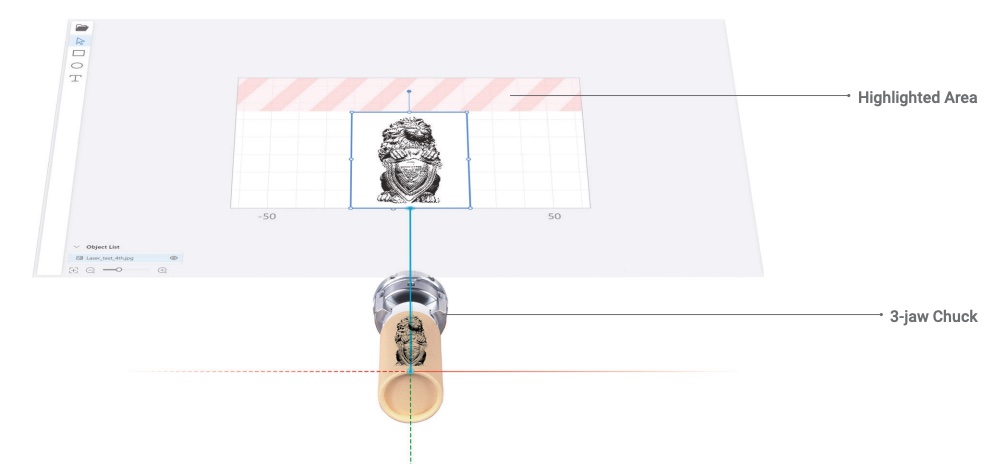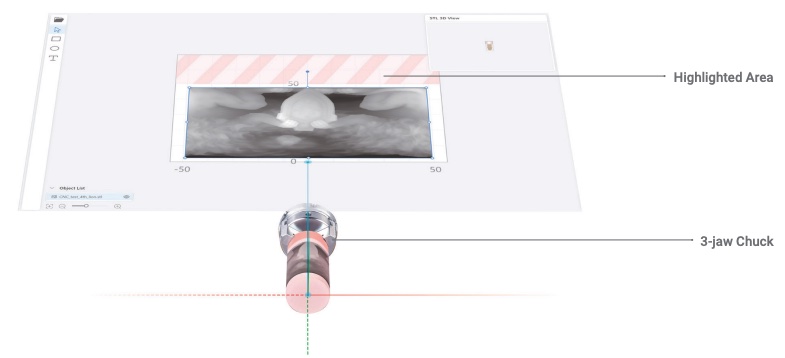¶ 01 What is Snapmaker Luban?
Snapmaker Luban (hereinafter Luban) is a free, all-in-one open-source software tailored for Snapmaker machines. Whether you're working with 3D printing, laser engraving, or CNC carving, Luban provides a user-friendly interface to seamlessly manage your creative projects. Get ready to unlock the full potential of your Snapmaker with Luban!
The outlook of Homepage will be slightly different based on the modules you selected.
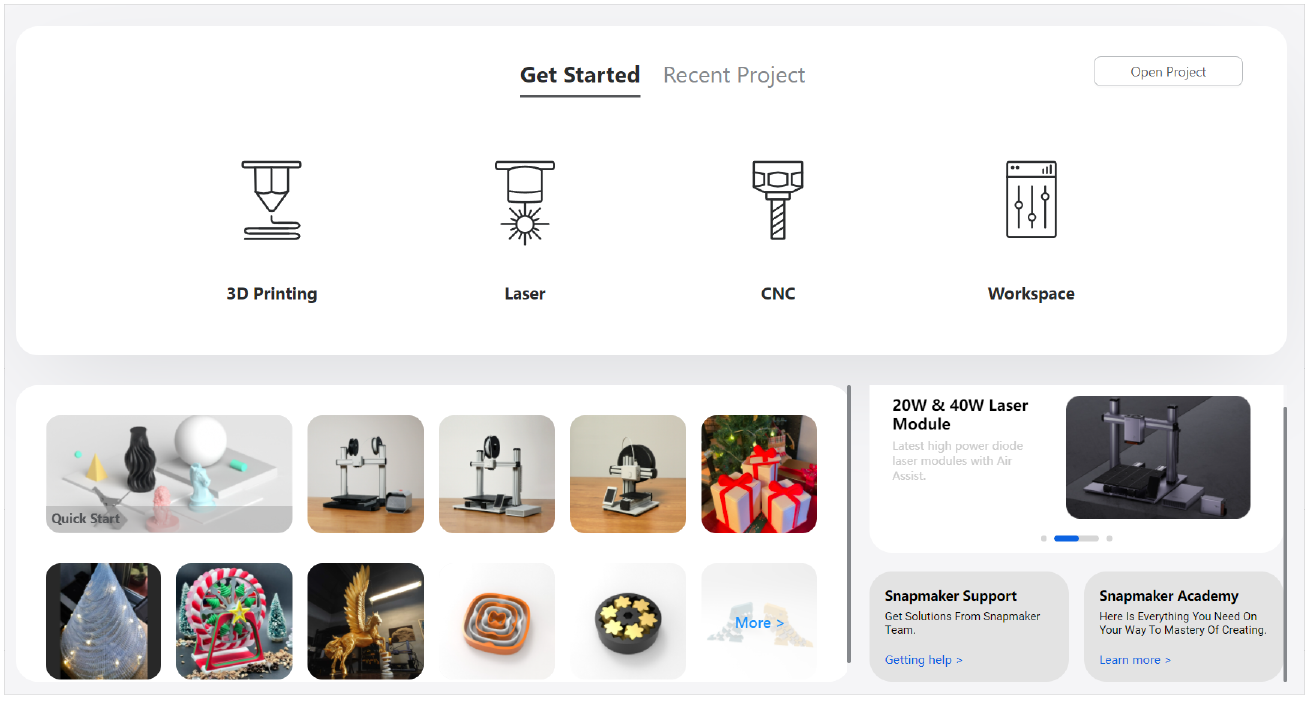
¶ 02 Download, Install & Update
If you have already installed Luban, we recommend you to update it to the latest version for the best user experience.
¶ 03 Configuration Wizard
If you are installing Luban for the first time, Luban will automatically pop up the Configuration Wizard, guiding you through the initial setup.
If you want to change these settings later on, click Settings on the top hidden menu.
¶ Step 1 Select Language
Please select a preferred language for your Luban interface.
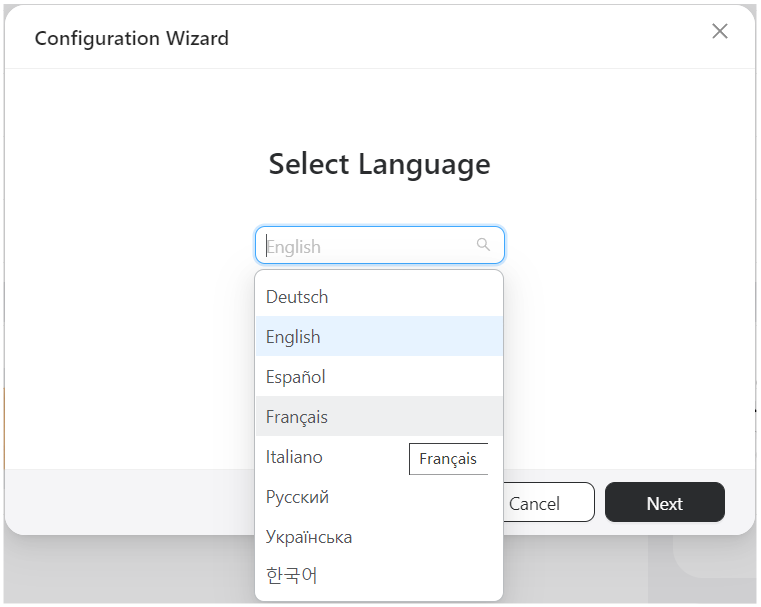
Currently, English, Chinese and German interface languages are well-developed, while other languages are still actively being improved.
¶ Step 2 Select Machine
Please select the correct machine type and module type. Then click Complete when finished.

Snapmaker 2.0 Dual Extrusion Module can also be used on Snapmaker Artisan, if you want to do so, please click
to activate 3D Print Head Setting and save your changes.
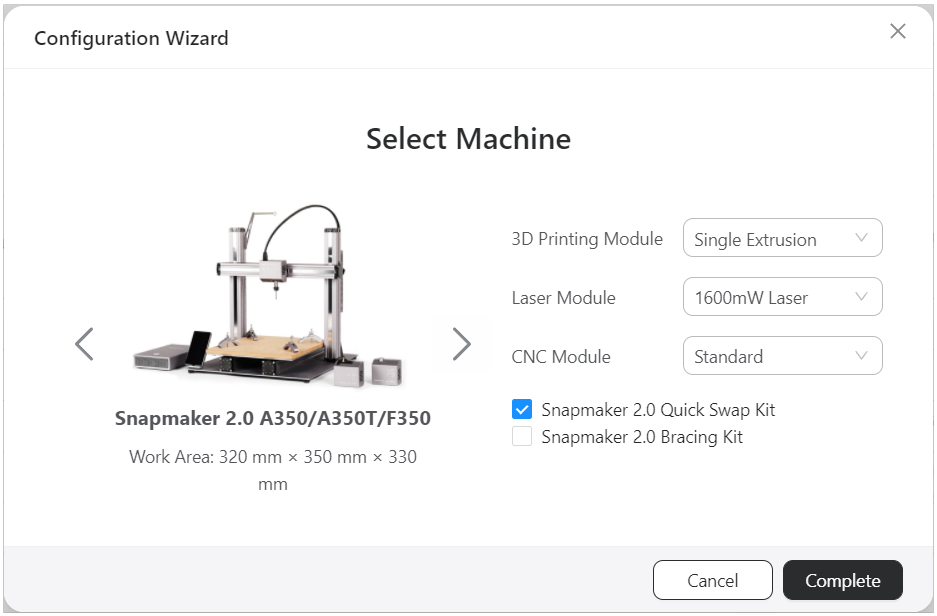
For 2.0 users, if you have installed Quick Swap Kit or Bracing Kit on the machine, please tick them in Luban as well. Failure to do so may result in abnormal operation or damage to the product, because there is a difference in the stroke of the Y axes and Z axes between the installation status with and without the Quick Swap Kit/Bracing Kit.
¶ 04 Connect the machine to Luban
It is recommended to connect the machine to Luban before starting your first job. Luban supports the connection via Wi-Fi or via the serial port. For details, please refer to the following instructions:
¶ 05 Start Your First Job
- Click 3D Printing to enter 3D Printing G-code Generator.

If you are using 3D printing function for the first time in Luban, Luban will automatically pop up the Beginner's Guide to guide you through the first job. You can follow Luban's Beginner's Guide to get familiar with Luban's 3D printing workflow. To access Beginner's Guide later on, click Help > Beginner's Guide on the top hidden menu.
- Click
 to import an object file into Luban. Luban-supported file formats include: .stl, .obj, .amf and .3mf.
to import an object file into Luban. Luban-supported file formats include: .stl, .obj, .amf and .3mf.
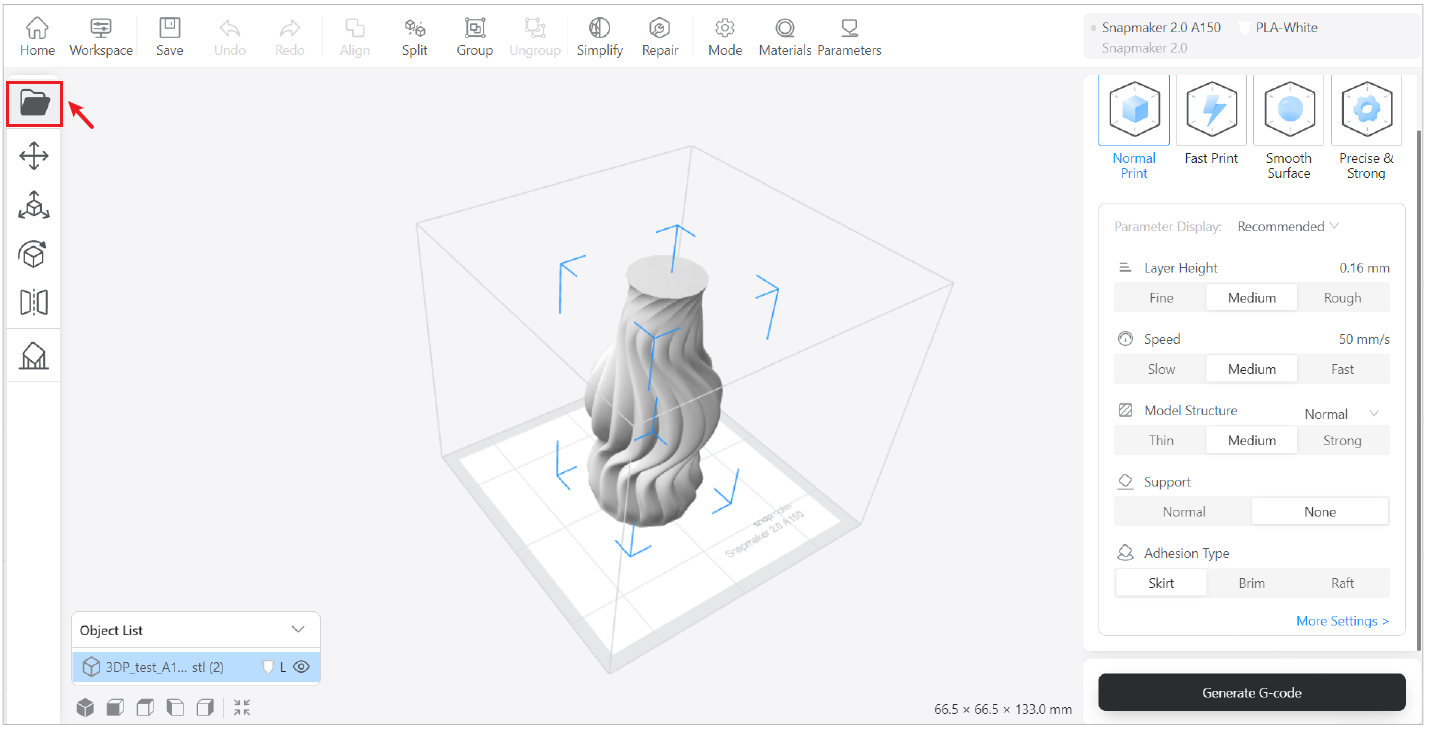
Please note that there may be bugs when importing files in .amf and .3mf. If you encounter any problems, please submit a support ticket to contact our technical support team.
- In the Object List, click the object name to select the object.
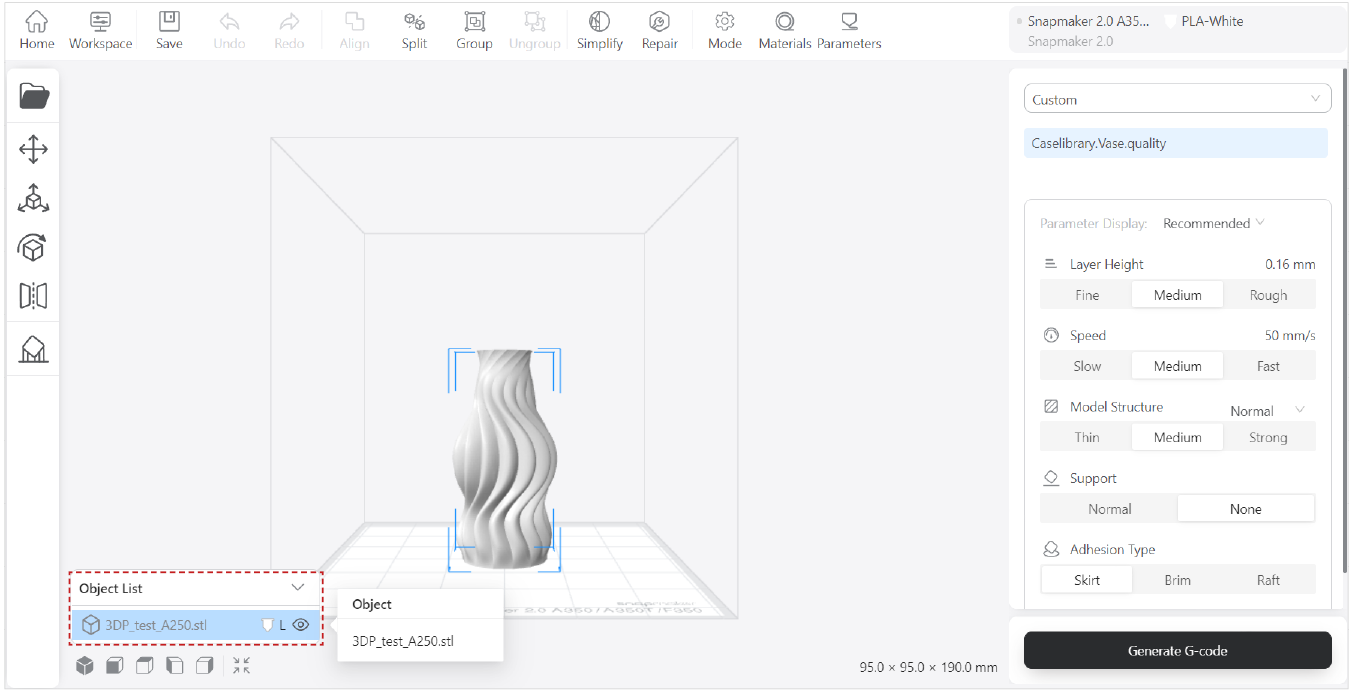
- Place or transform the object using Move, Scale, Rotate, Mirror and Support tools.
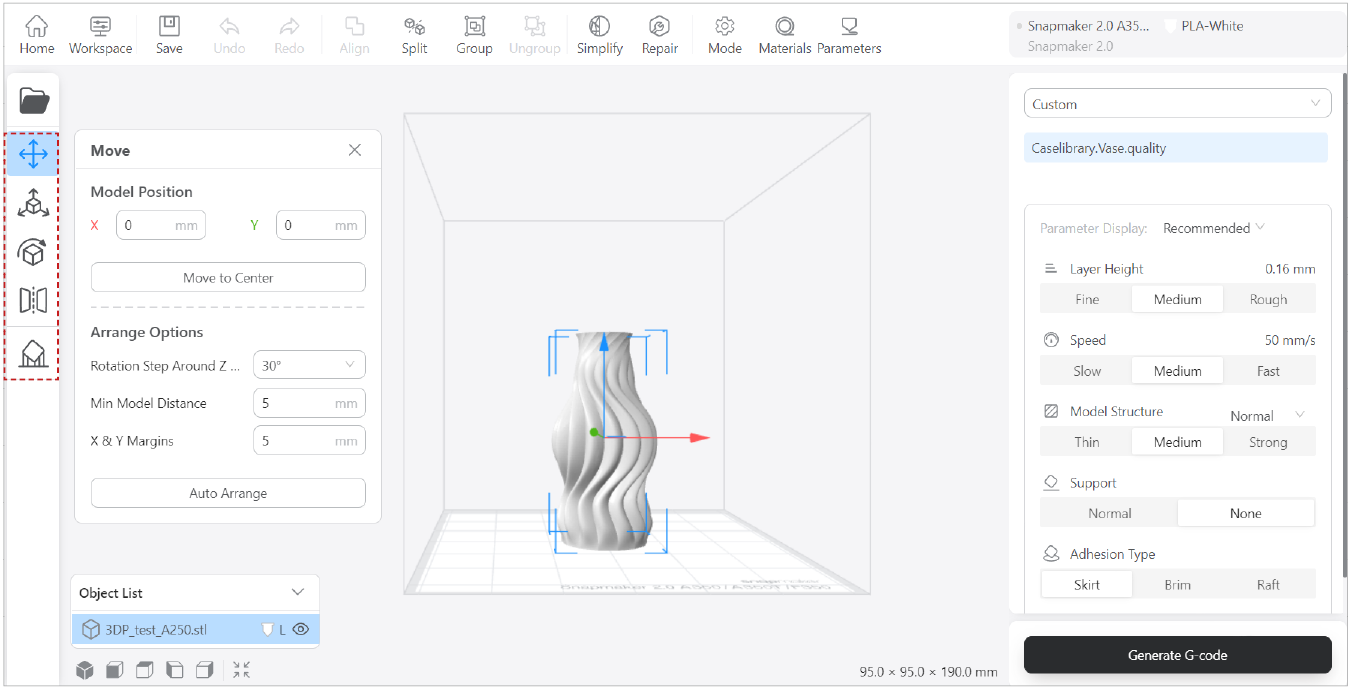
- Based on your needs, arrange and edit objects with Align, Split, Group, Ungroup, Simplify and Repair tools.
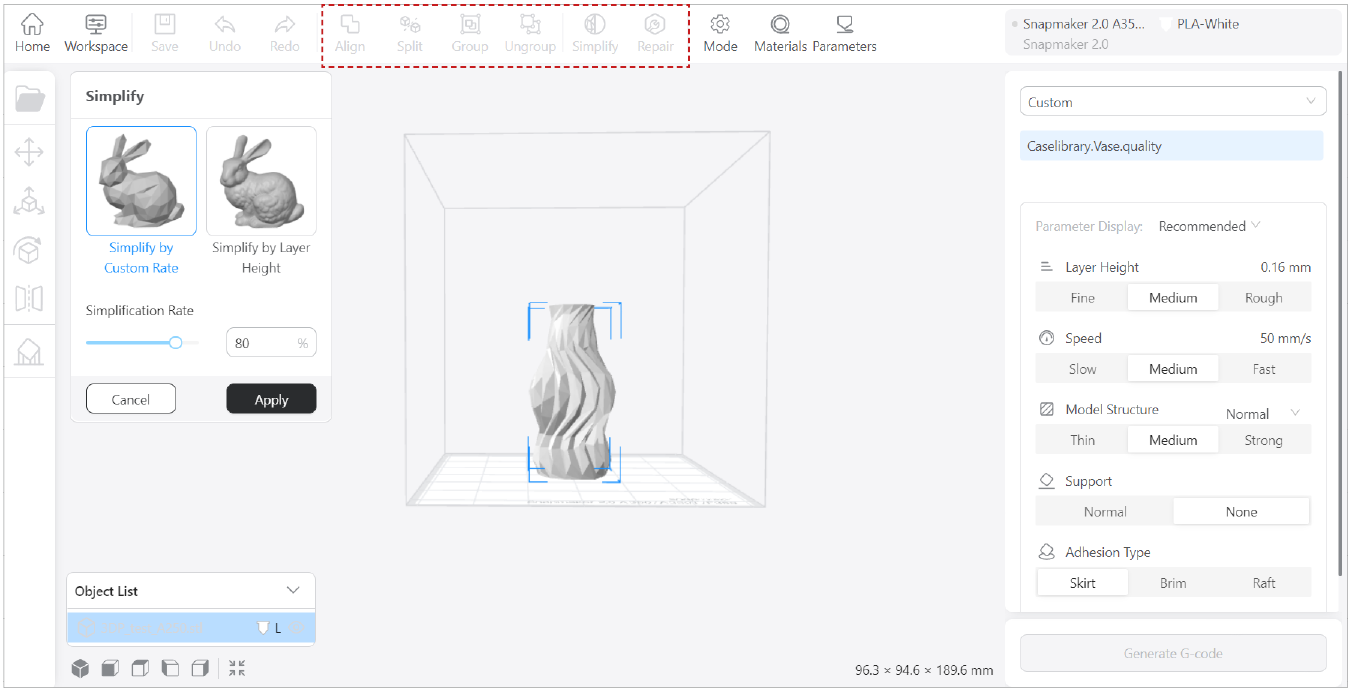
- Click the top right conner of interface to enter Select Material pane, then specify the material for your extruder.


Make sure that the filaments that will be loaded on the machine later on are the same as the ones assigned in Luban. Otherwise, print failure might occur.
- On the right configuration bar, select a print profile (a set of settings you want to print the model in). Then configure the print parameters if needed.
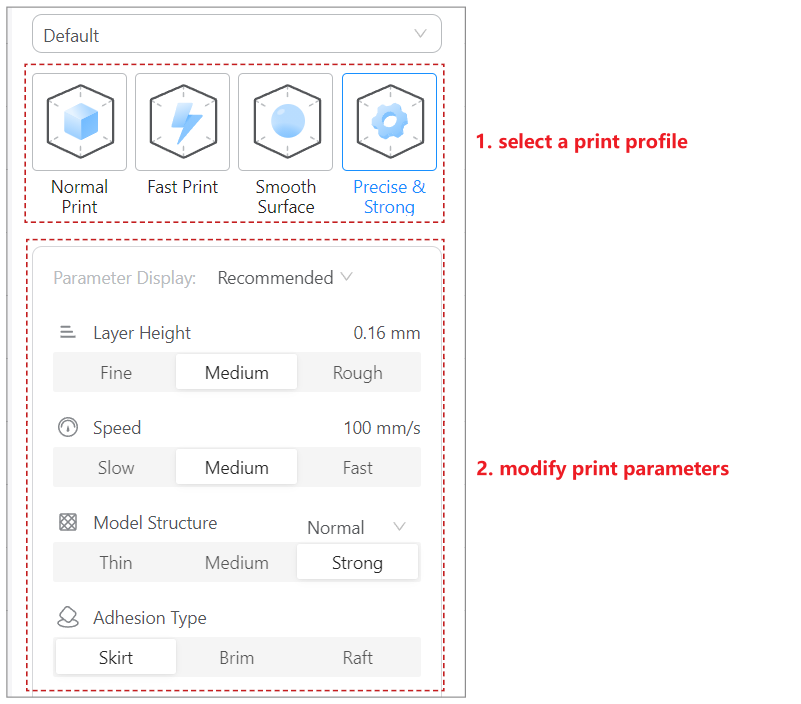
- Click Generate G-code. Once done, Luban will direct you to the Preview pane to preview the sliced effect.
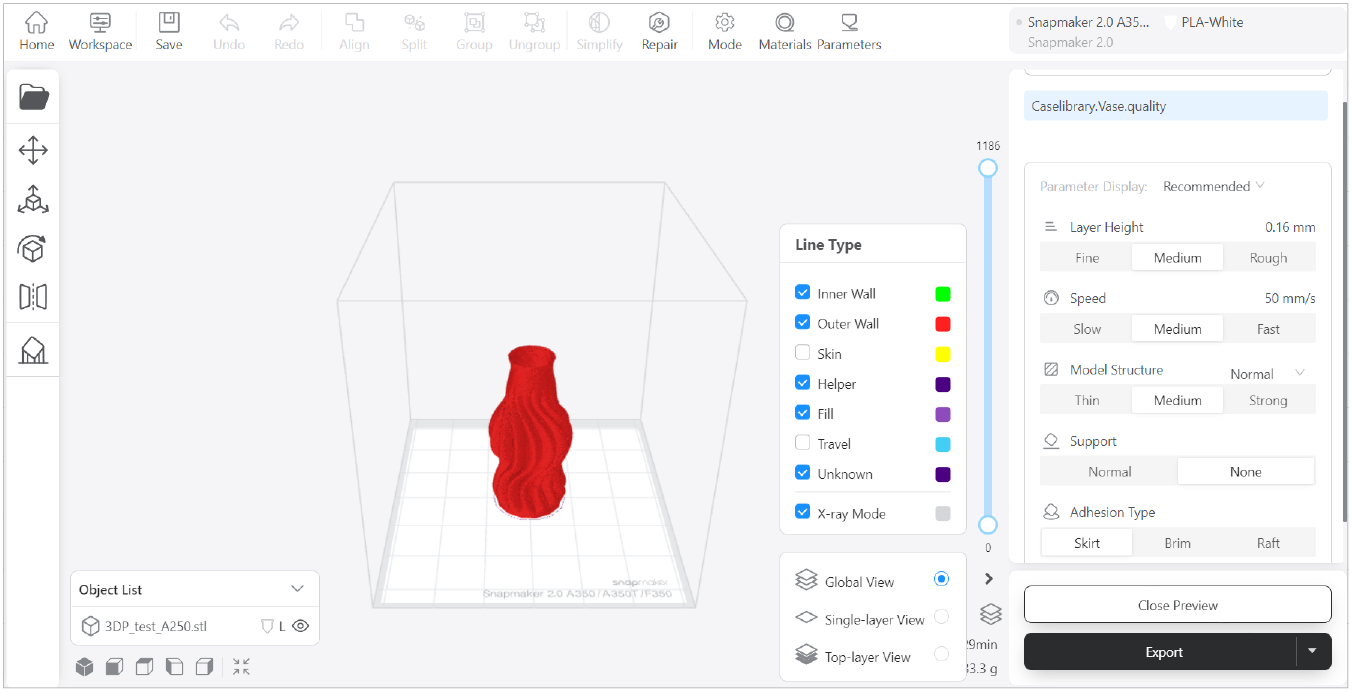
- Click Export > Load G-code to Workspace.
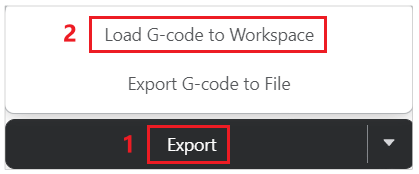
Alternatively, you can also click Export G-code to File to export it to USB flash drive, then transfer it to your machine and start printing on Touchscreen.
- Click Start on Luban.

Alternatively, you can also click Send to Device to send the G-code file to Touchscreen and print it there.
Before starting the job, make sure that you have finished heated bed leveling, Z offset calibration and loaded the filament.
- Click 3D Printing to enter 3D Printing G-code Generator.

If you are using 3D printing function for the first time in Luban, Luban will automatically pop up the Beginner's Guide to guide you through the first job. You can follow Luban's Beginner's Guide to get familiar with Luban's 3D printing workflow. To access Beginner's Guide later on, click Help > Beginner's Guide on the top hidden menu.
- Click
 to import an object file into Luban. Luban-supported file formats include: .stl, .obj, .amf and .3mf.
to import an object file into Luban. Luban-supported file formats include: .stl, .obj, .amf and .3mf.
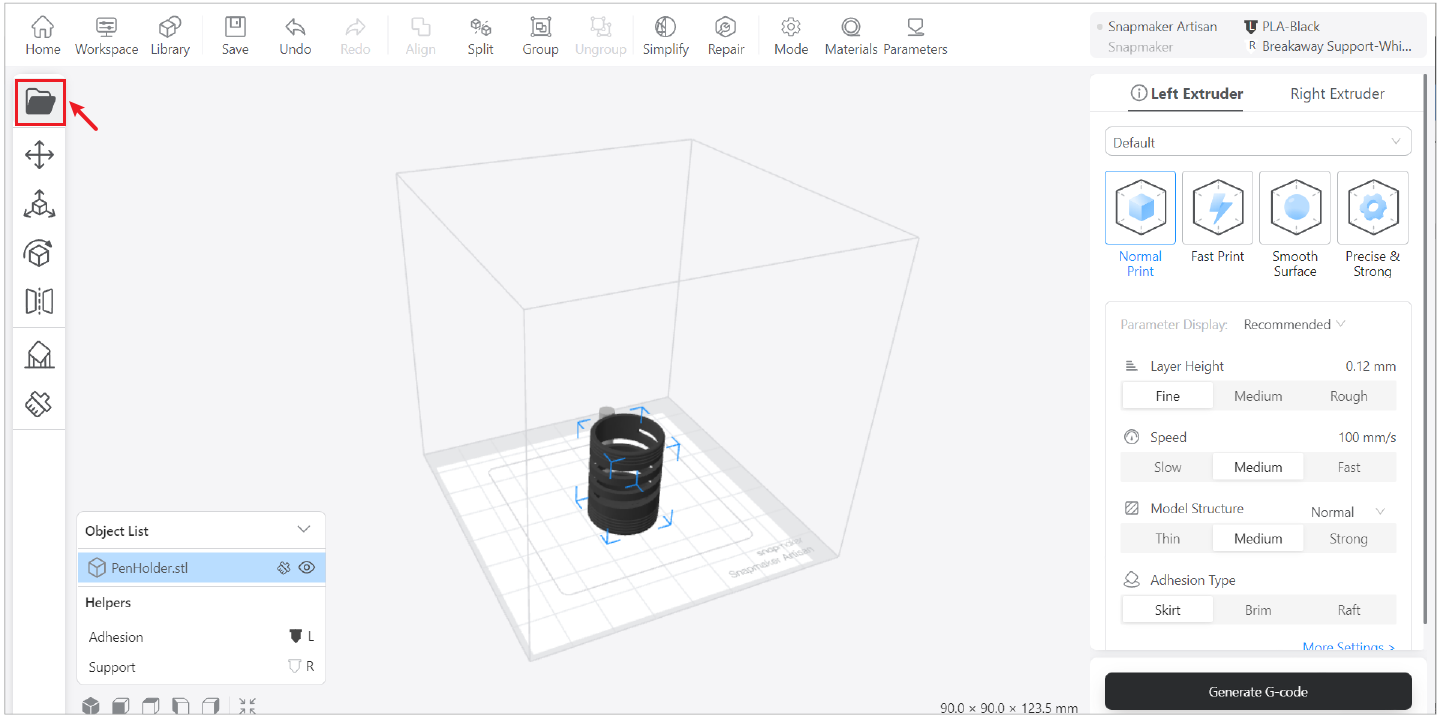
Please note that there may be bugs when importing files in .amf and .3mf. If you encounter any problems, please submit a support ticket to contact our technical support team.
- Select the object. Then in then Object List, assign extruder for the selected objects. In such way, Luban will know which extruder you want to use for the print.
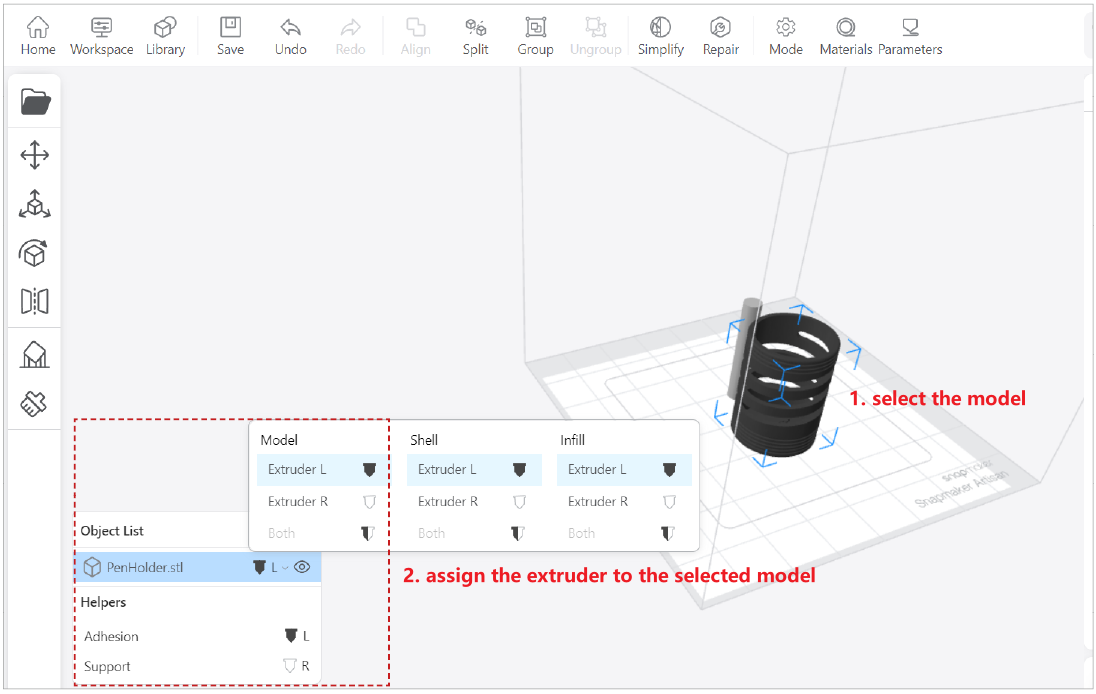
The grey cylinder generated together with your model is the prime tower, which is enabled for dual extruder printing by default. When changing colors, there might be some residual material left inside the nozzle. With prime tower enabled, the extruder can extrude these residues out during printing the prime tower. As a result, the surface of the prime tower absorbs a lot of defects and looks hairy, while the model is more be more clean and tidy.
- Place or transform the object using Move, Scale, Rotate, Mirror, Support and Mesh Painting tools.
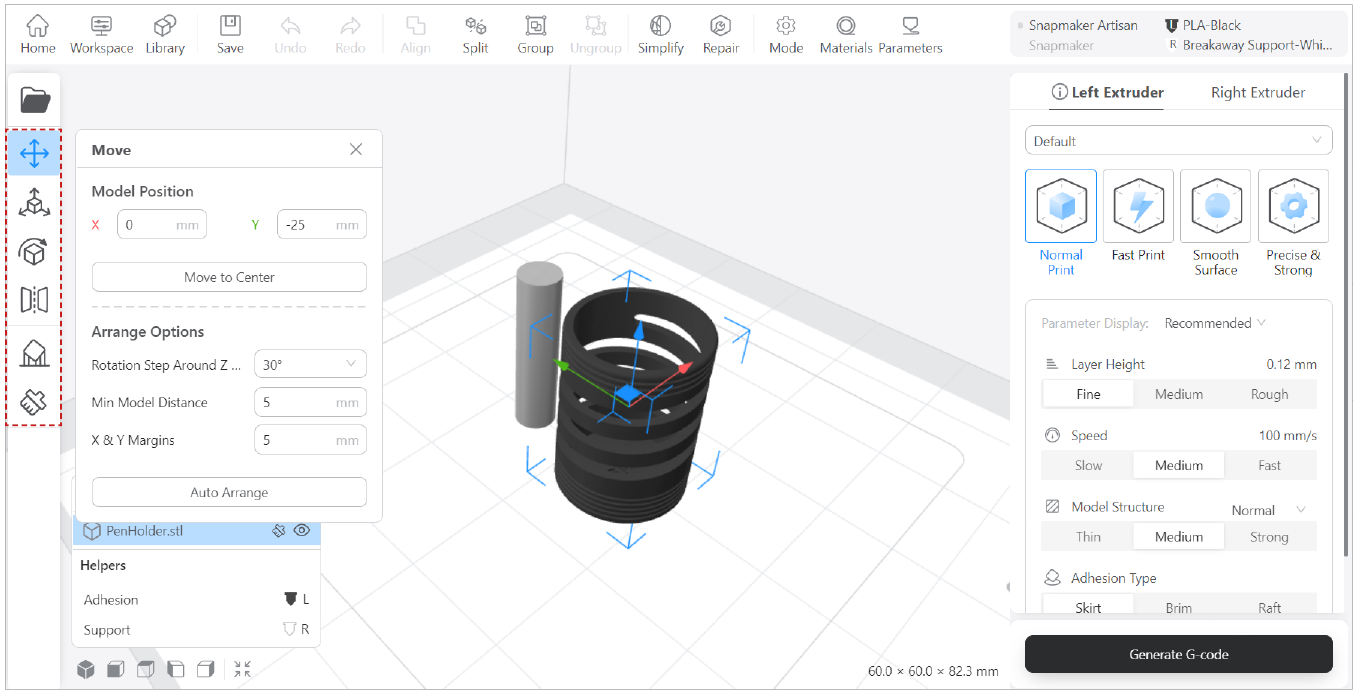
- Based on your needs, arrange and edit objects with Align, Split, Group, Ungroup, Simplify and Repair tools.
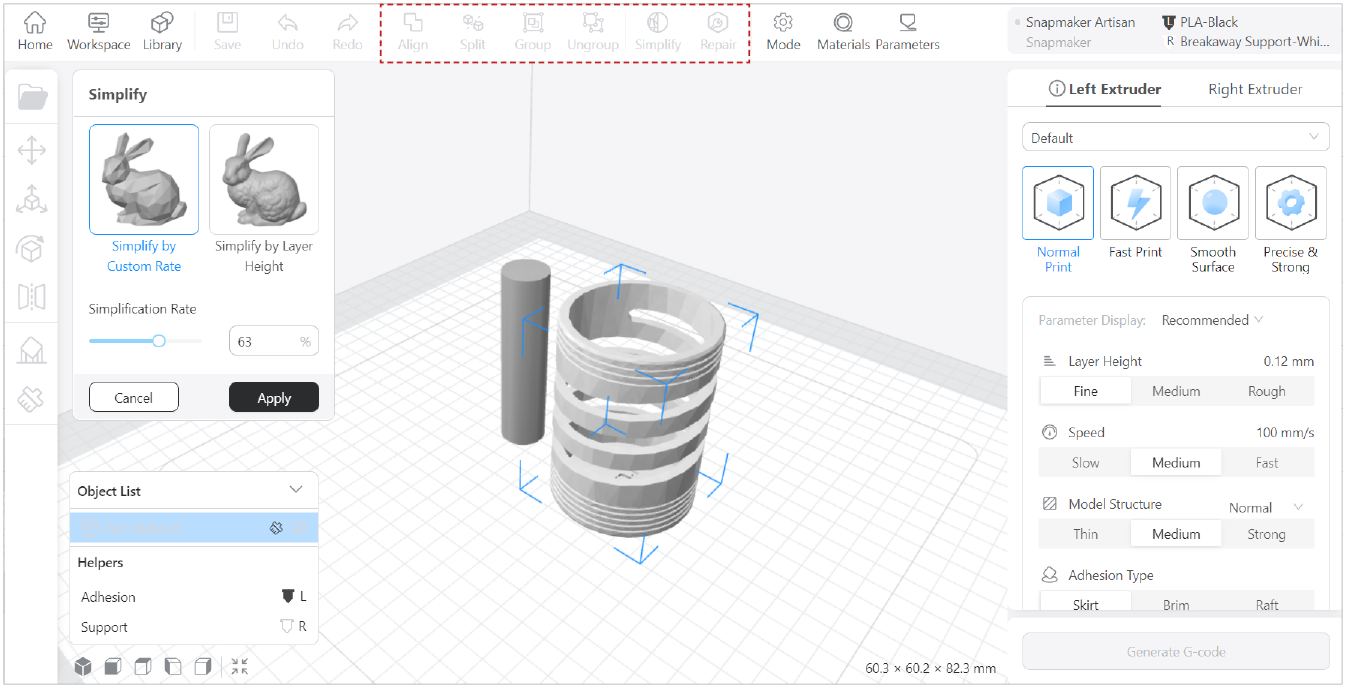
- Click the top right conner of interface to enter Select Material pane, then specify the material for the left and right extruder, respectively.


Make sure that the filaments that will be loaded on the machine later on are the same as the ones assigned in Luban. Otherwise, print failure might occur.
- On the right configuration bar, for each extruder, select a print profile (a set of settings you want to print the model in). Then configure the print parameters if needed.
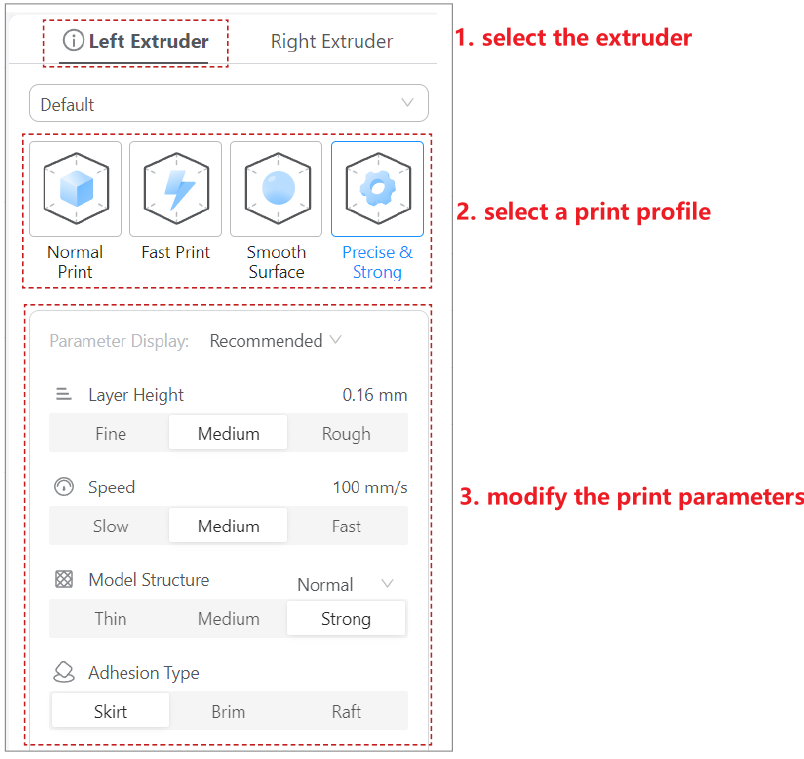
- Click Generate G-code. Once done, Luban will direct you to the Preview pane to preview the sliced effect.
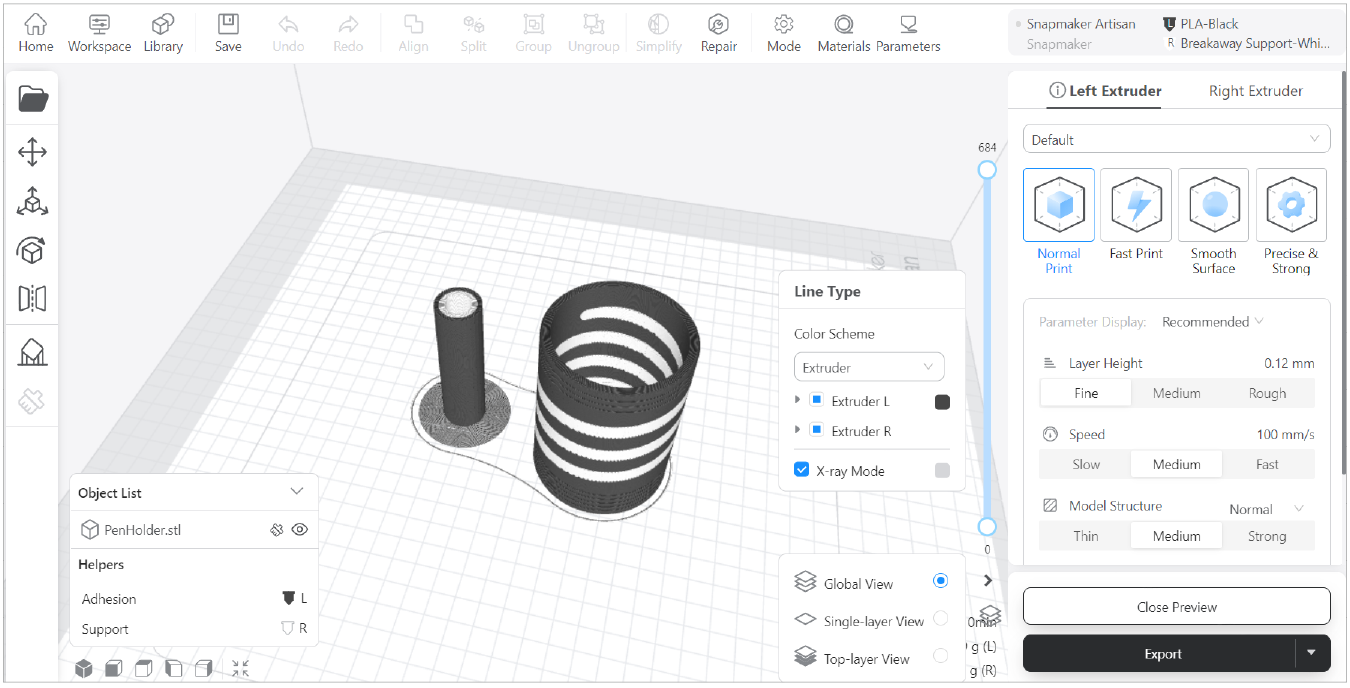
- Click Export > Load G-code to Workspace.

Alternatively, you can also click Export G-code to File to export it to USB flash drive, then transfer it to your machine and start printing on Touchscreen.
- Click Start on Luban.
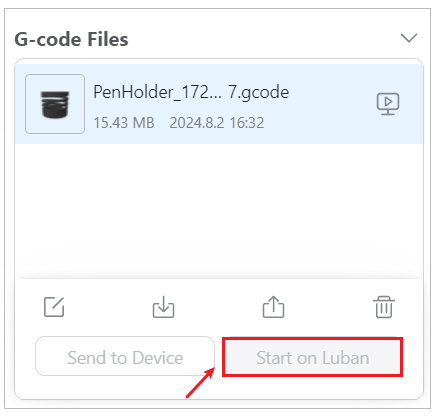
Alternatively, you can also click Send to Device to send the G-code file to Touchscreen and print it there.
Before starting the job, make sure that you have finished heated bed leveling, XYZ offset calibration and loaded the filament.
- Click Laser > 3-axis to enter Laser G-code Generator.

If you are using laser function for the first time in Luban, Luban will automatically pop up the Beginner's Guide to guide you through the first job. You can follow Luban's Beginner's Guide to get familiar with Luban's laser workflow. To access Beginner's Guide later on, click Help > Beginner's Guide on the top hidden menu.
Since V4.9.1, Luban fully supports inline mode for laser work. Under this mode, laser power can be perfectly synchronized with every move and allows for real-time adjustments to the laser power during motion, which is useful especially for high-speed image engraving. Luban enables it by default, however, you need to ensure that you have upgraded the firmware to the latest.
- Before importing the design into Luban, you need to finish the Job Setup for your laser project. First input the width and height of your workpiece, then select an origin mode and origin position. Click Confirm when finished.
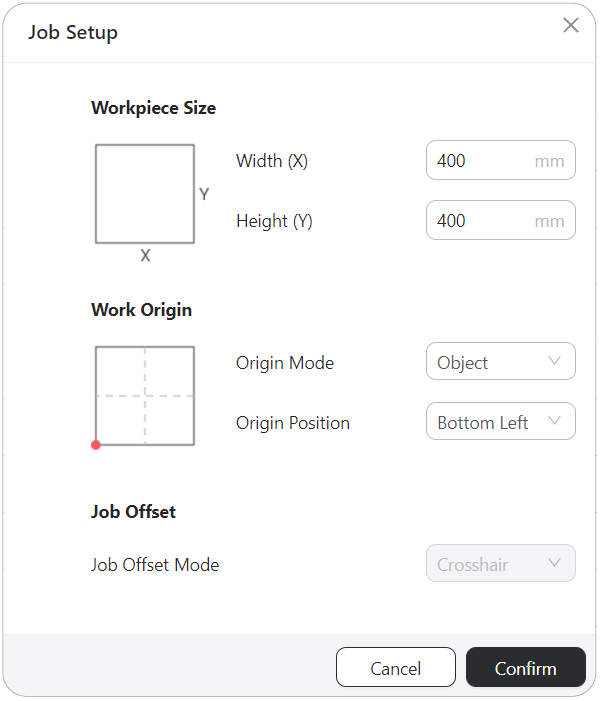
For more details in Job Setup, you can refer to - Laser Job Setup > 3-axis.
- Click
 to import an object file into Luban. Luban-supported file formats include: .stl, .svg, .jpeg, .png, .jpg, .bmp, .dxf, .amf and .3mf.
to import an object file into Luban. Luban-supported file formats include: .stl, .svg, .jpeg, .png, .jpg, .bmp, .dxf, .amf and .3mf.
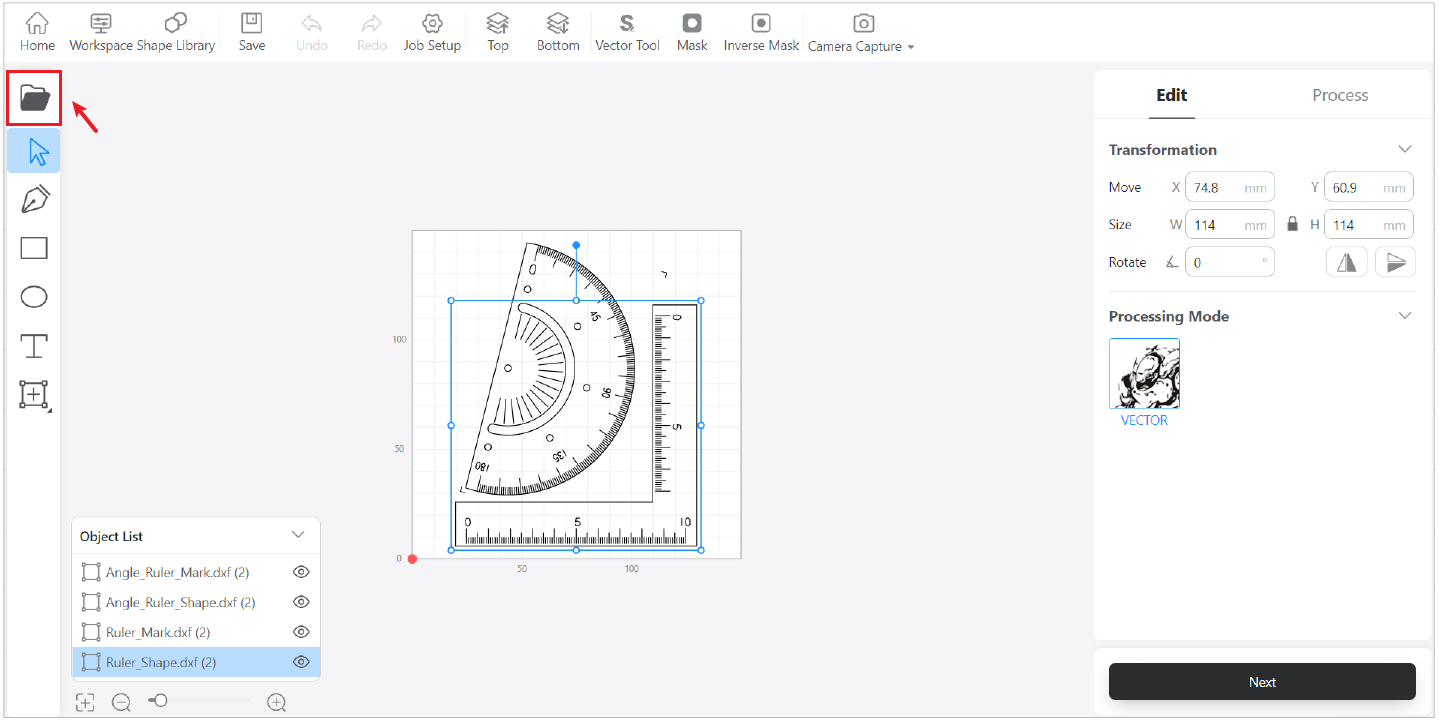
Please note that there may be bugs when importing files in .amf and .3mf. If you encounter any problems, please submit a support ticket to contact our technical support team.
Snapmaker Luban cannot guarantee compatibility with all .dxf files exported from various software. For those .dxf files that are compatible, the parsing results may vary depending on the software used for export.
- Alternatively, you can draw simple objects, add text or insert vector shapes for laser work.
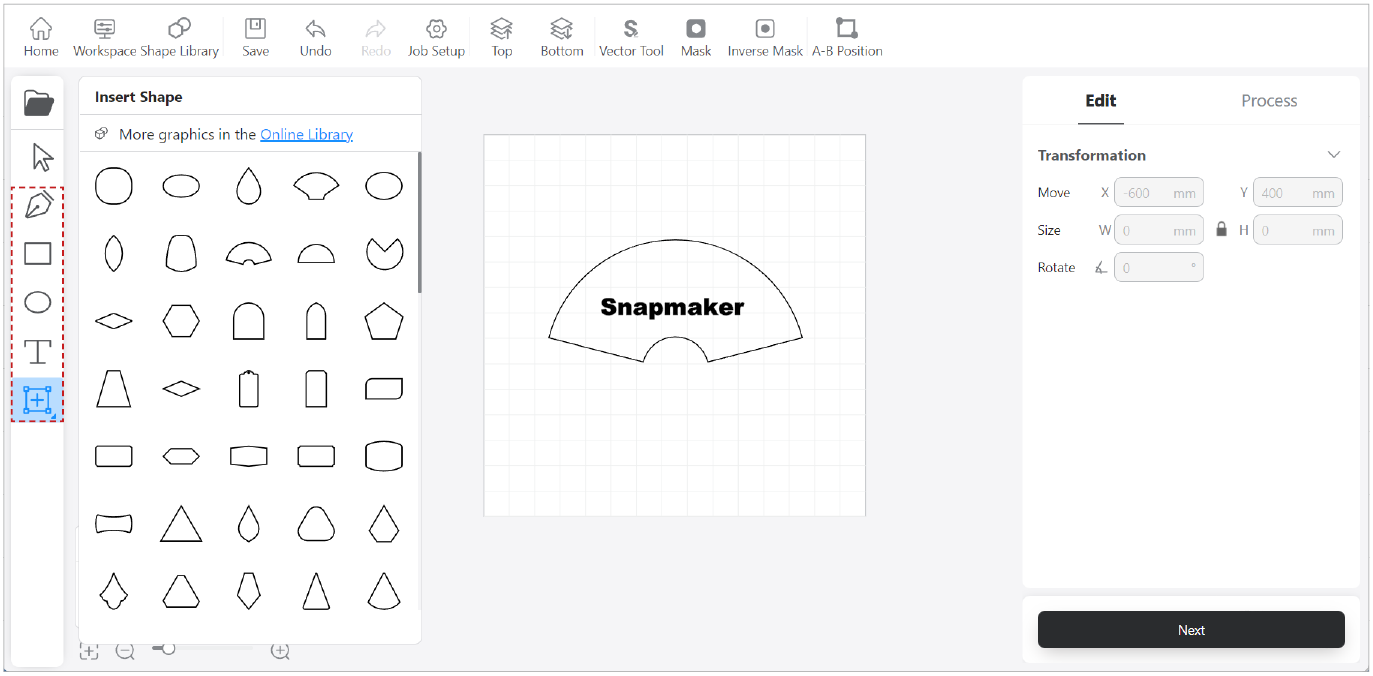
- Select the object, then Luban will display the Edit Panel where you can transform the object, switch the Processing Mode. Besides, you can also edit the objects with the tools in the top toolbar, e.g., vector tool. Then click Next when you finish editting, Luban will direct you to Process Panel.
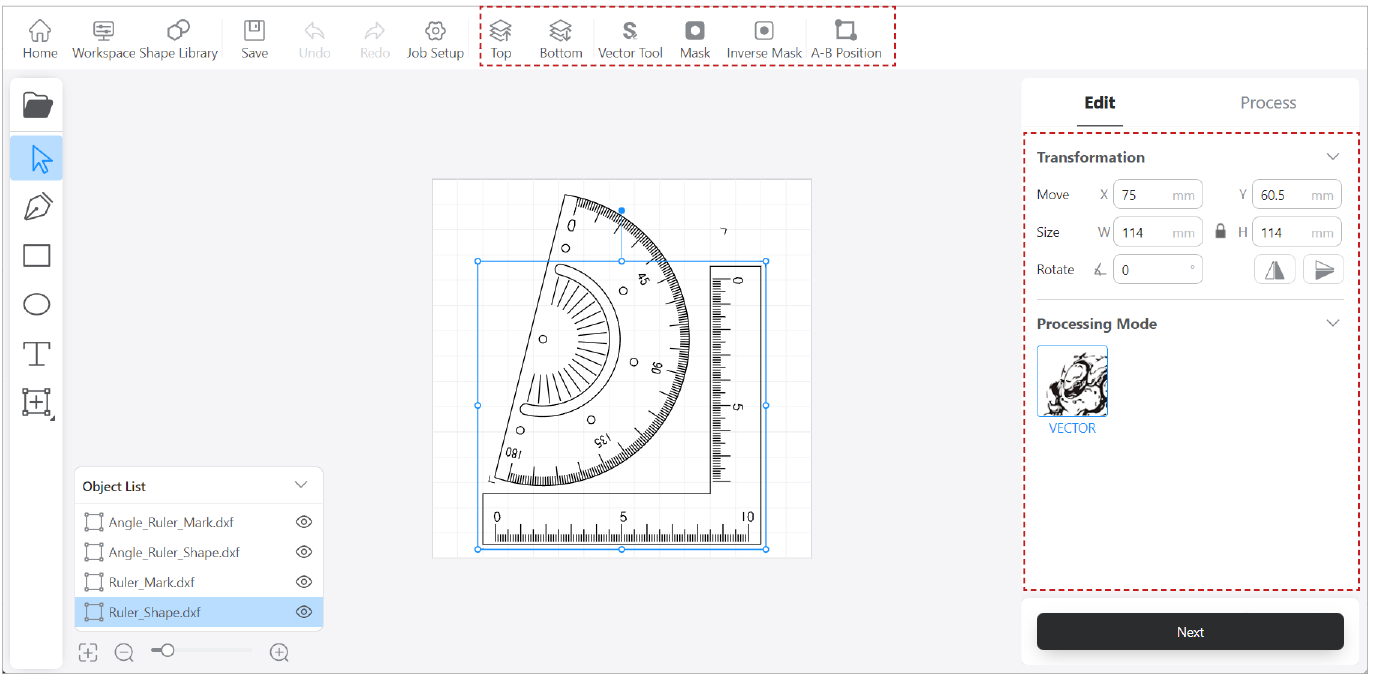
- In the Process Panel, select the object, then click Create Toolpath to create a toolpath for the object.
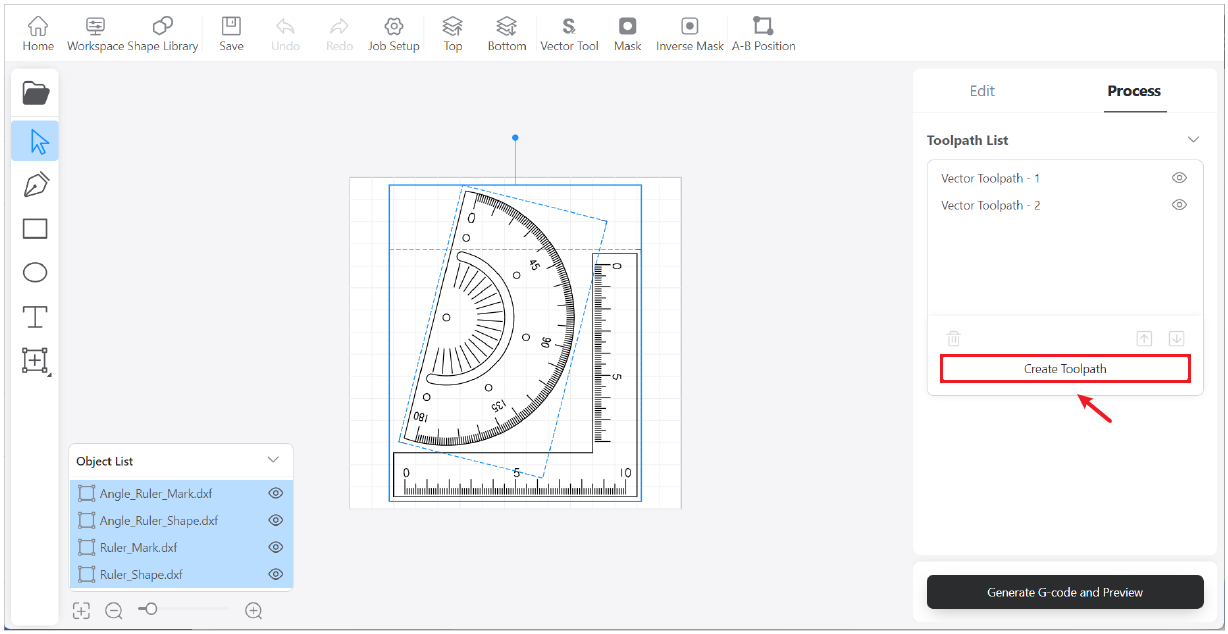
- In the pop up Toolpath Settings, use Luban's default settings, then click Save.
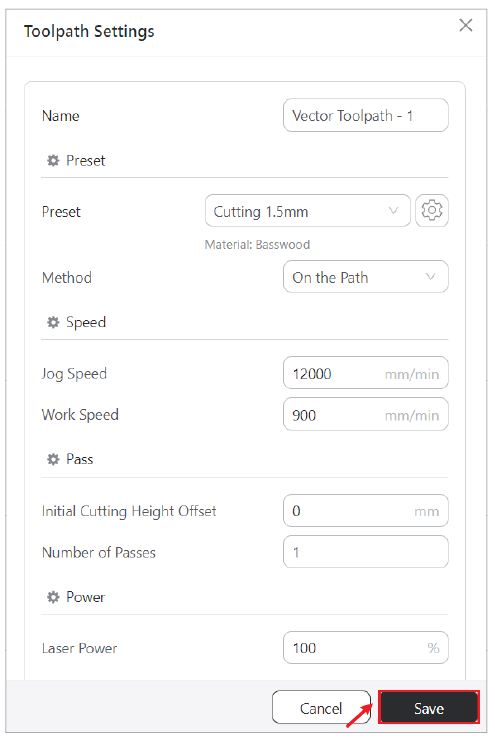
You can also modify the parameters based on your needs.
-
Click Generate G-code. Once done, Luban will direct you to the Preview pane to preview the sliced effect.
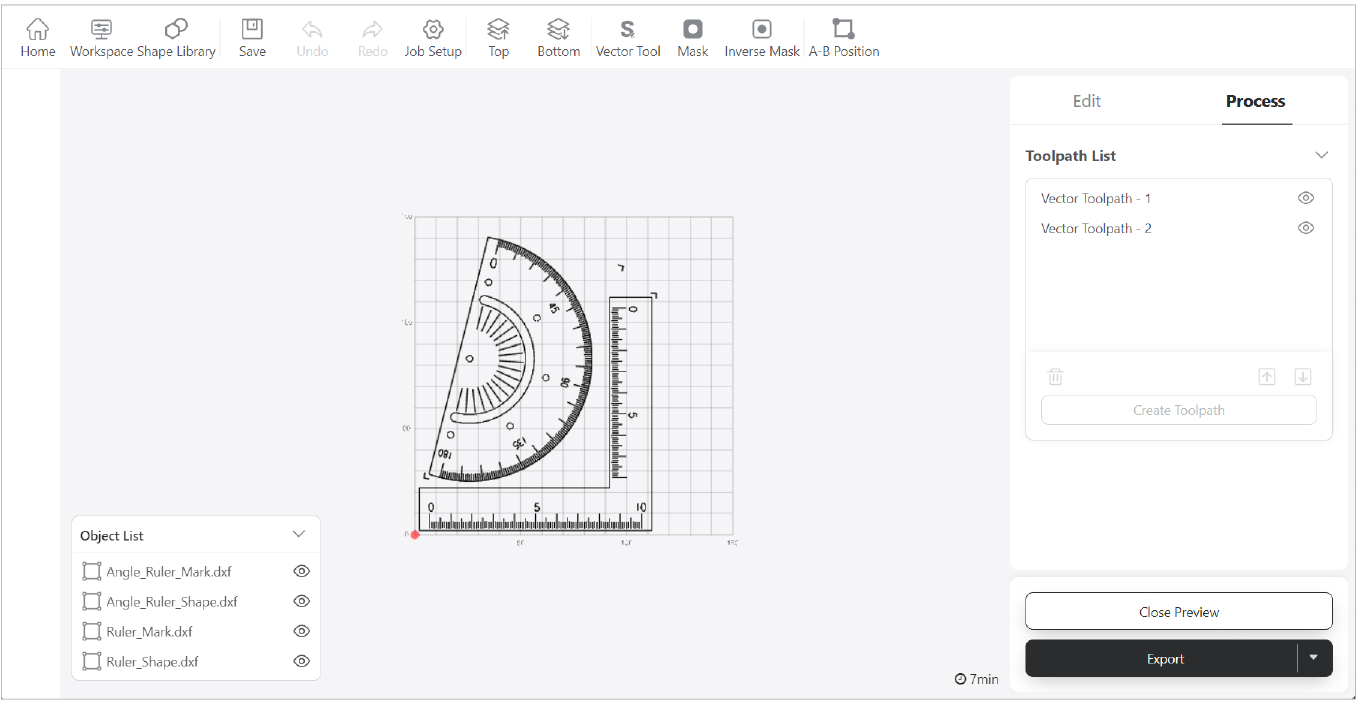
-
Start the laser engraving or cutting job. For details, please refer to - Start laser engraving or cutting on Luban.
For 1.6W and 10W Laser Module, if you don't want to set the work origin, you can use Luban's Camera Capture function; For 2W IR/20W/40W Laser Module, if you don't want to set the work origin, you can use Luban's A-B position function.
- Click Laser > 4-axis to enter Laser G-code Generator.
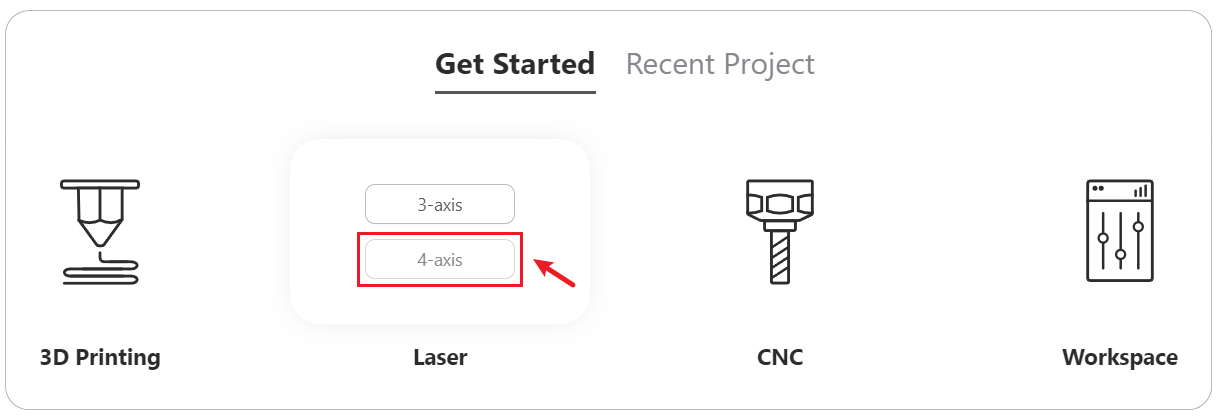
If you are using laser function for the first time in Luban, Luban will automatically pop up the Beginner's Guide to guide you through the first job. You can follow Luban's Beginner's Guide to get familiar with Luban's laser workflow. To access Beginner's Guide later on, click Help > Beginner's Guide on the top hidden menu. To access Beginner's Guide later on, click Help > Beginner's Guide on the top hidden menu.
Since V4.9.1, Luban fully supports inline mode for laser work. Under this mode, laser power can be perfectly synchronized with every move and allows for real-time adjustments to the laser power during motion, which is useful especially for high-speed image engraving. Luban enables it by default, however, you need to ensure that you have upgraded the firmware to the latest.
- Before importing the design into Luban, you need to finish the Job Setup for your laser project. Input the length and diameter of your workpiece. Click Confirm when finished.
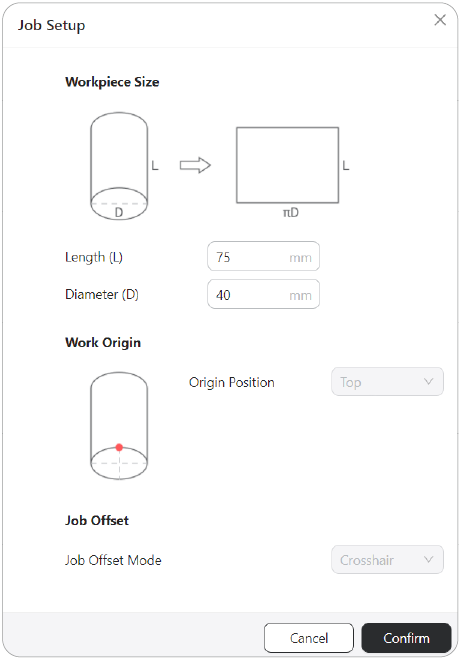
For more details in Job Setup, you can refer to - Laser Job Setup > 4-axis.
- Click
 to import an object file into Luban. Luban-supported file formats include: .stl, .svg, .jpeg, .png, .jpg, .bmp, .dxf, .amf and .3mf.
to import an object file into Luban. Luban-supported file formats include: .stl, .svg, .jpeg, .png, .jpg, .bmp, .dxf, .amf and .3mf.
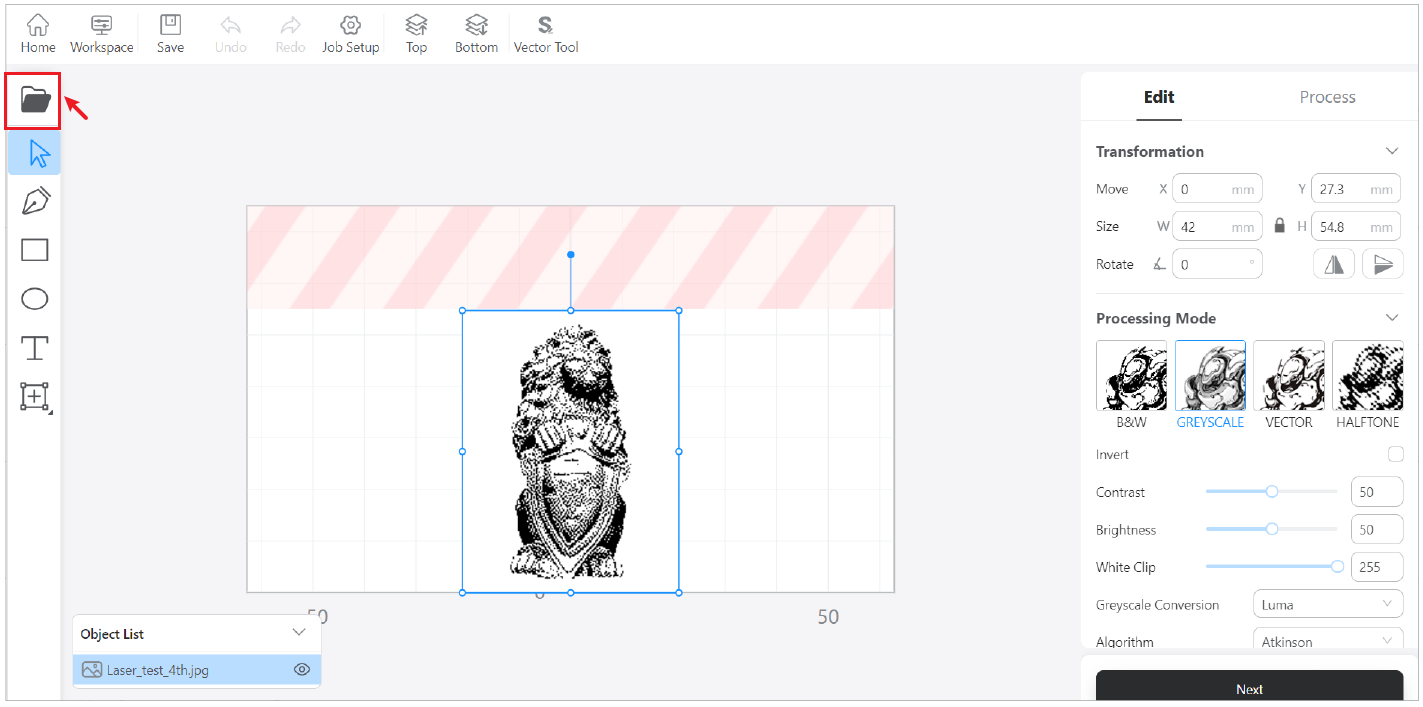
Please note that there may be bugs when importing files in .amf and .3mf. If you encounter any problems, please submit a support ticket to contact our technical support team.
Snapmaker Luban cannot guarantee compatibility with all .dxf files exported from various software. For those .dxf files that are compatible, the parsing results may vary depending on the software used for export.
- Alternatively, you can draw simple objects, add text or insert vector shapes for laser work.

The canvas in the Snapmaker Luban equals the lateral area of your material. After you input the diameter and length of your material, Luban will adjust the size of the canvas. You should put your object within the canvas. The stripe-highlighted area is where the material is clamped by the 3-jaw chuck.
- Select the object, then Luban will display the Edit Panel where you can transform the object, switch the Processing Mode. Besides, you can also edit the objects with the tools in the top toolbar, e.g., vector tool. Then click Next when you finish editting, Luban will direct you to Process Panel.
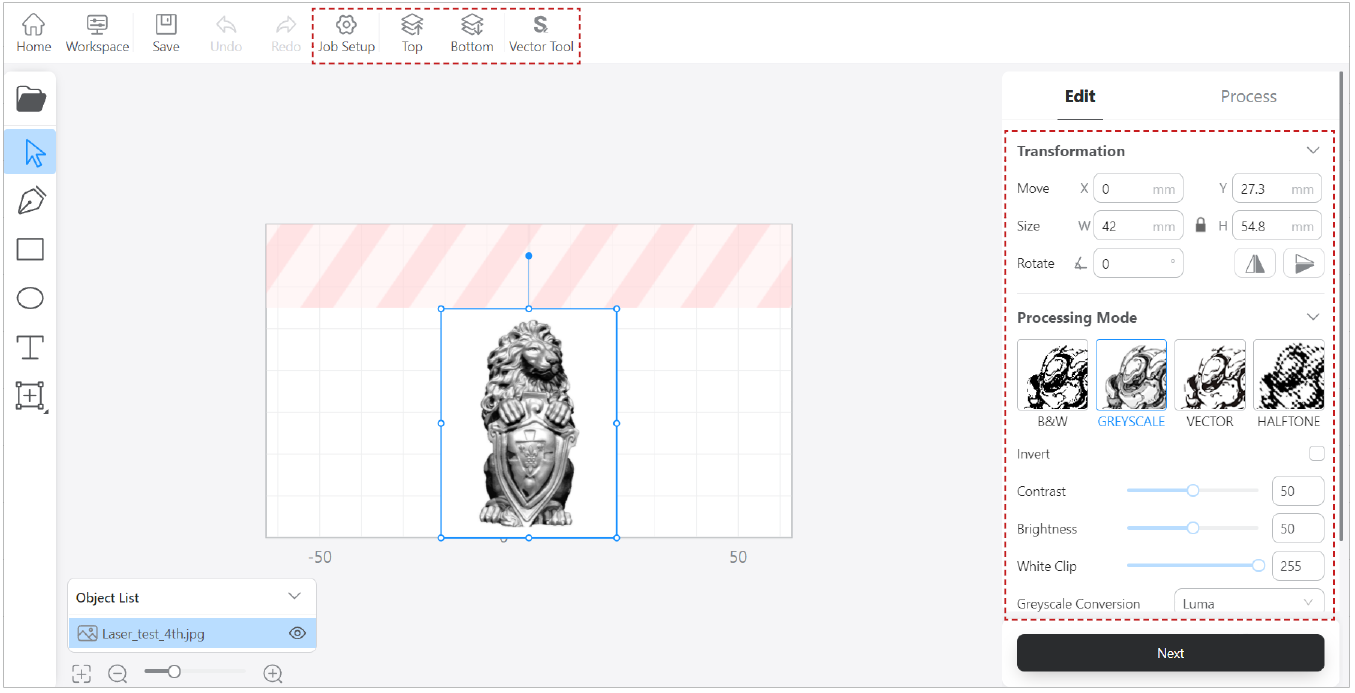
- In the Process Panel, select the object, then click Create Toolpath to create a toolpath for the object.
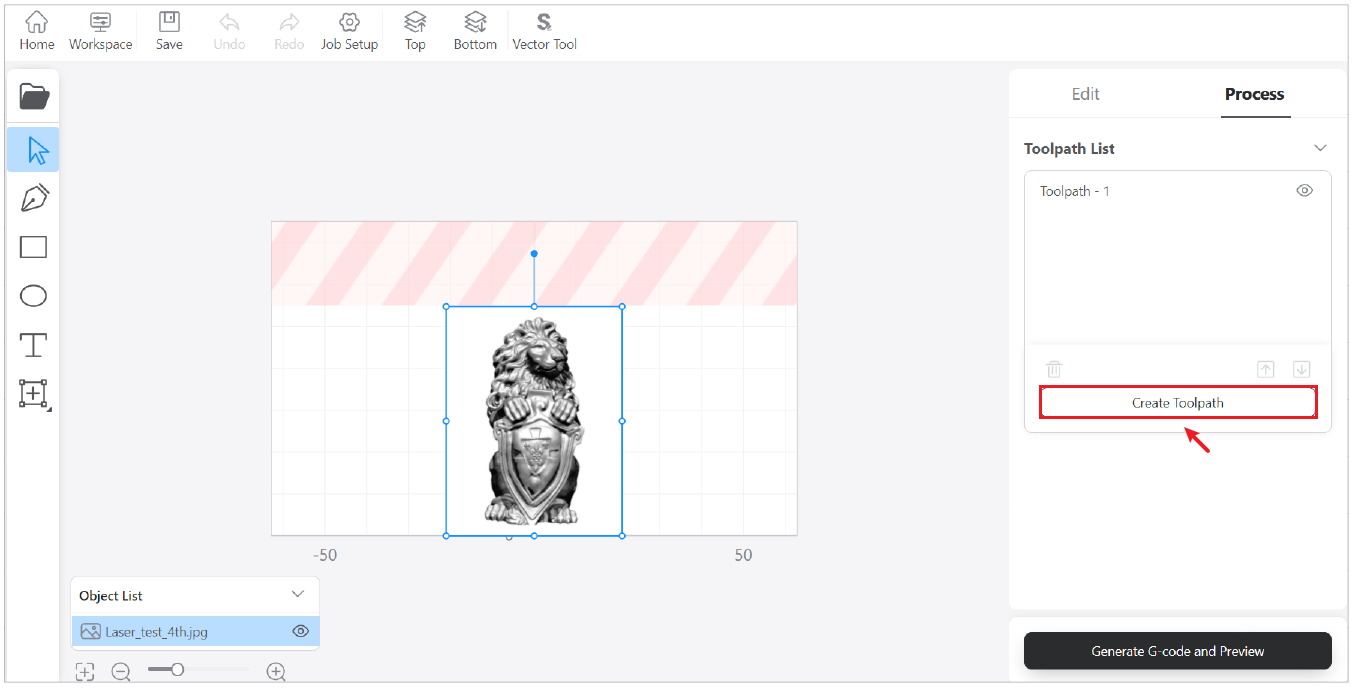
- In the pop up Toolpath Settings, use Luban's default settings, then click Save.
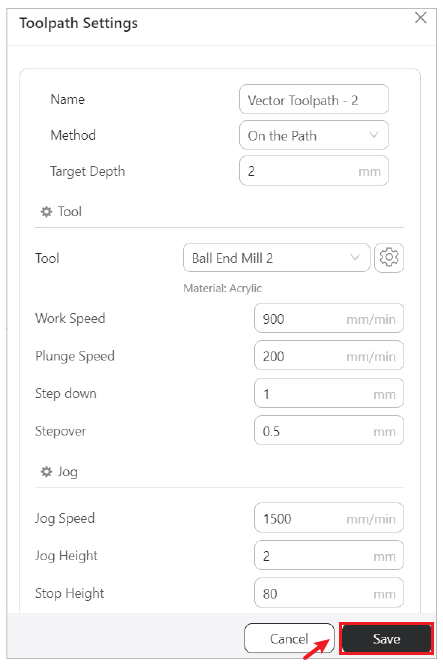
You can also modify the parameters based on your needs.
-
Click Generate G-code. Once done, Luban will direct you to the Preview pane to preview the sliced effect.
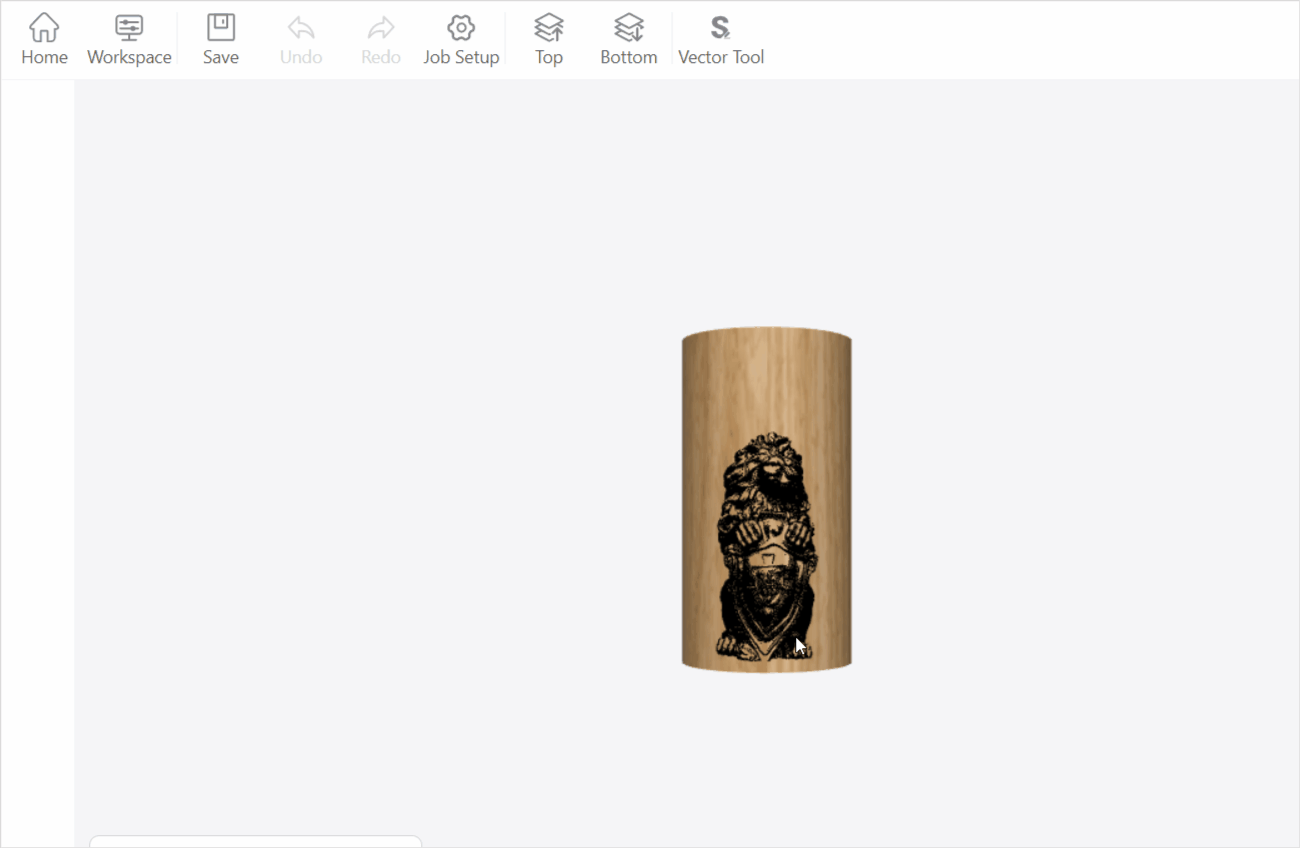
-
Start the laser engraving or cutting job. For details, please refer to - Start laser engraving or cutting on Luban.
For 1.6W and 10W Laser Module, if you don't want to set the work origin, you can use Luban's Camera Capture function; For 2W IR/20W/40W Laser Module, if you don't want to set the work origin, you can use Luban's A-B position function.
- Click CNC > 3-axis to enter CNC G-code Generator.

If you are using CNC carving or cutting function for the first time in Luban, Luban will automatically pop up the Beginner's Guide to guide you through the first job.You can follow Luban's Beginner's Guide to get familiar with Luban's CNC workflow. To access Beginner's Guide later on, click Help > Beginner's Guide on the top hidden menu.
- Before importing the design into Luban, you need to finish the Job Setup for your laser project. First input the width and height of your workpiece, then select whether to use locking block and origin position. Click Confirm when finished.
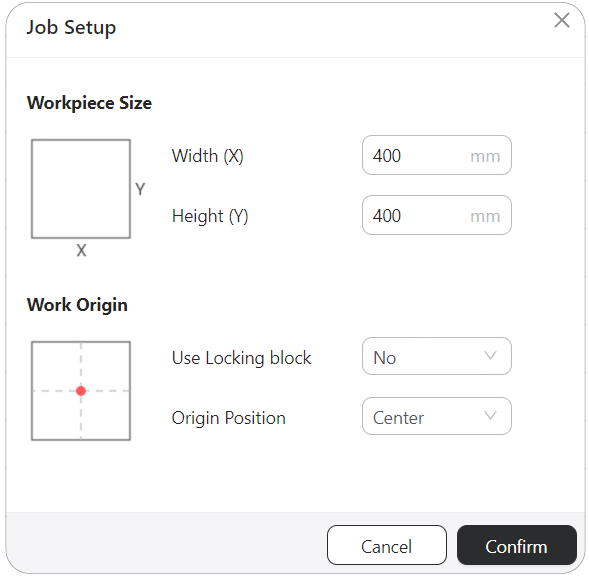
For more details in Job Setup, you can refer to - CNC Job Setup > 3-axis.
- Click
 to import an object file into Luban. Luban-supported file formats include:.svg, .dxf, .png, .jpg, .jpeg, .bmp, .stl, .amf and .3mf.
to import an object file into Luban. Luban-supported file formats include:.svg, .dxf, .png, .jpg, .jpeg, .bmp, .stl, .amf and .3mf.
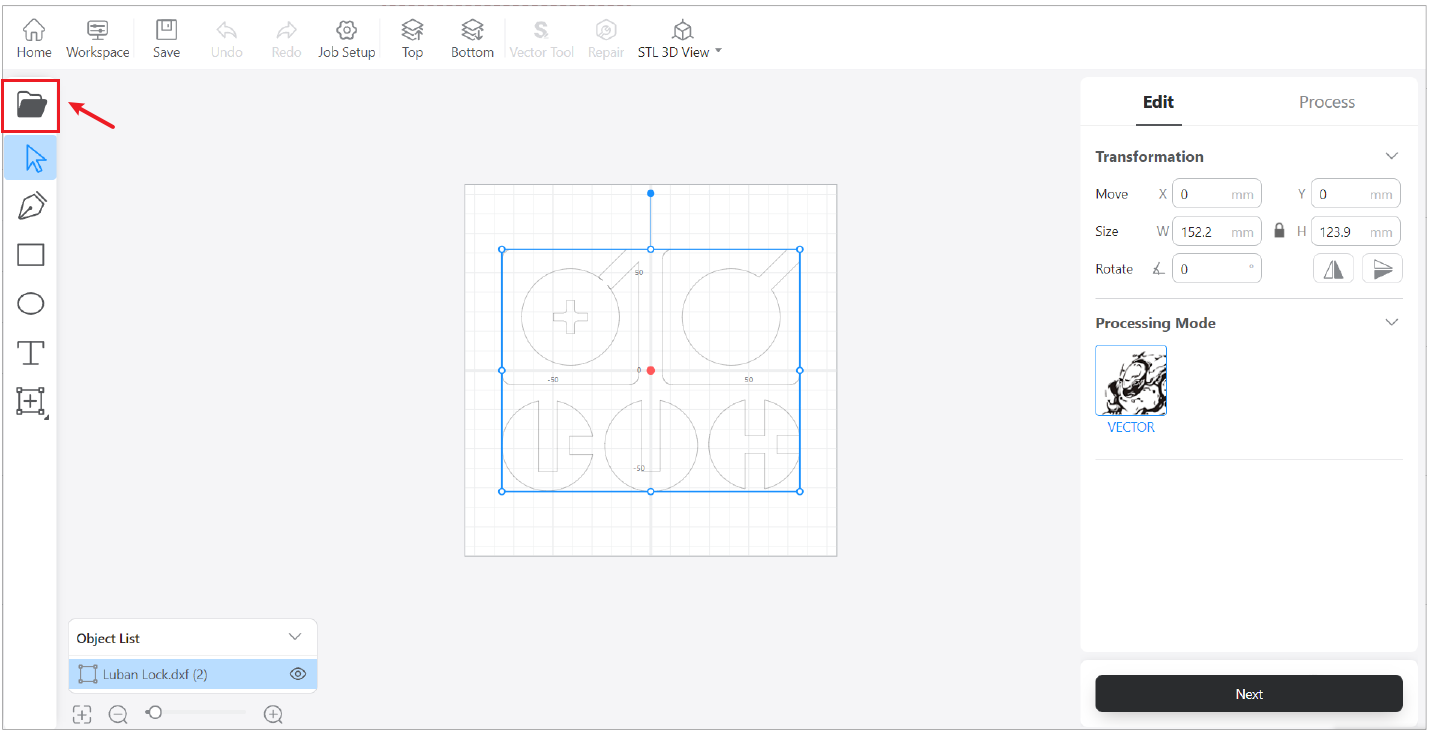
Please note that there may be bugs when importing files in .amf and .3mf. If you encounter any problems, please submit a support ticket to contact our technical support team.
-
Alternatively, you can draw simple objects, add text or insert vector shapes for CNC work.

-
Select the object, then Luban will display the Edit Panel where you can transform the object, switch the Processing Mode. Besides, you can also edit the objects with the tools in the top toolbar, e.g., vector tool. Then click Next when you finish editting, Luban will direct you to Process Panel.

-
In the Process Panel, select the object, then click Create Toolpath to create a toolpath for the object.
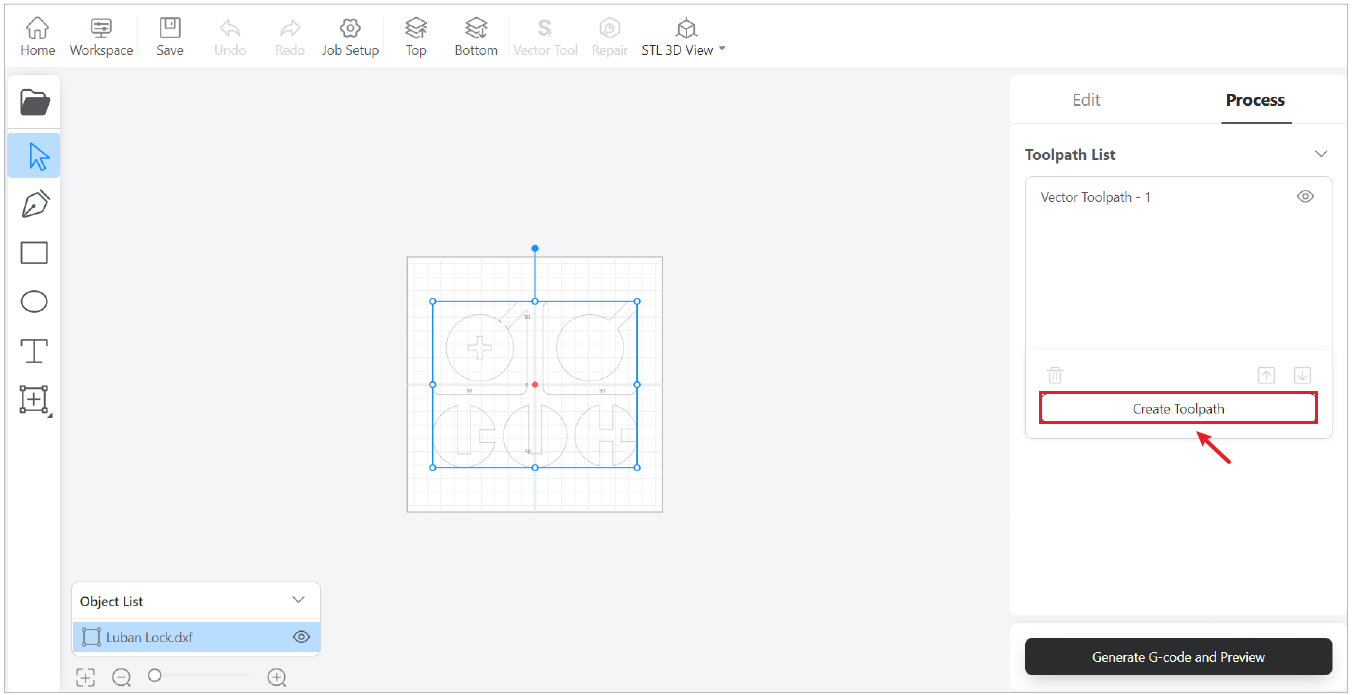
-
In the pop up Toolpath Settings, use Luban's default settings, then click Save.

You can also modify the parameters based on your needs.
- Click Generate G-code. Once done, Luban will direct you to the Preview pane to preview the sliced effect.
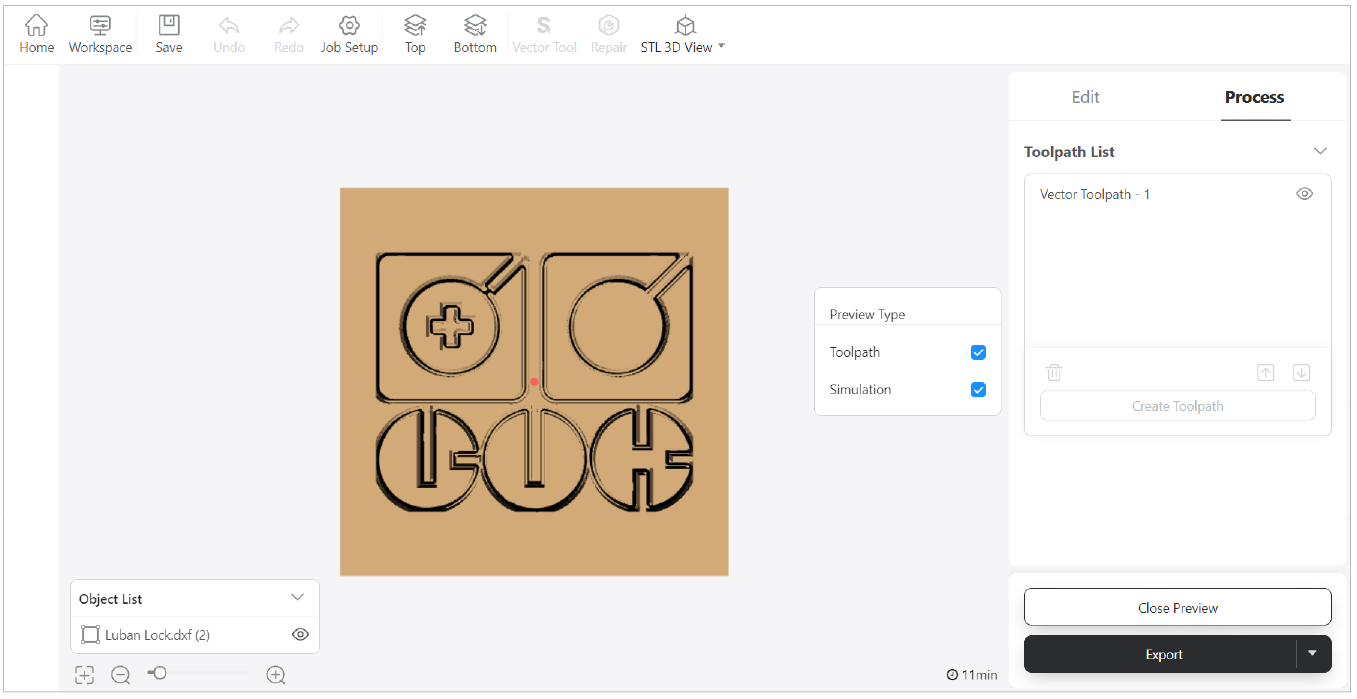
- Click Export > Load G-code to Workspace.

Alternatively, you can also click Export G-code to File to export it to USB flash drive, transfer it to your machine, then follow the Touchscreen instructions to start CNC engraving or cutting it there.
- Click Start on Luban.
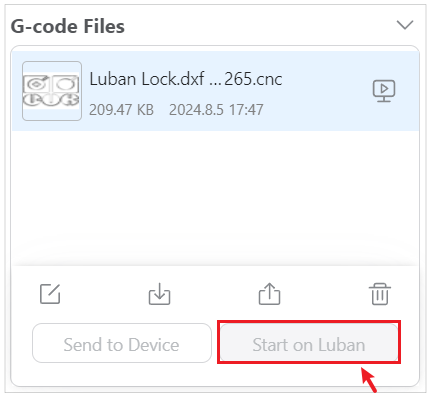
Before clicking Start on Luban, make sure that you have clamped the material, installed CNC bit and set the work origin. And run boundary to check if the work origin are correct.
Alternatively, you can also click Send to Device to send the G-code file to Touchscreen, then follow the Touchscreen instructions to start CNC engraving or cutting it there.
- Click CNC > 4-axis to enter CNC G-code Generator.

If you are using CNC carving or cutting function for the first time in Luban, Luban will automatically pop up the Beginner's Guide to guide you through the first job.You can follow Luban's Beginner's Guide to get familiar with Luban's CNC workflow. To access Beginner's Guide later on, click Help > Beginner's Guide on the top hidden menu.
- Before importing the design into Luban, you need to finish the Job Setup for your laser project. Input the length and diameter of your workpiece. Click Confirm when finished.
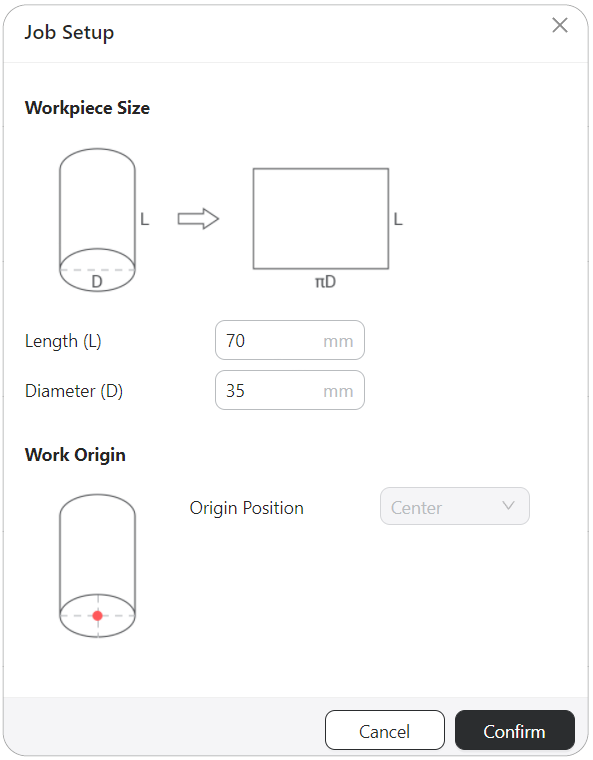
For more details in Job Setup, you can refer to - CNC Job Setup > 4-axis.
- Click
 to import an object file into Luban. Luban-supported file formats include: .svg, .dxf, .png, .jpg, .jpeg, .bmp, .stl, .amf and .3mf.
to import an object file into Luban. Luban-supported file formats include: .svg, .dxf, .png, .jpg, .jpeg, .bmp, .stl, .amf and .3mf.
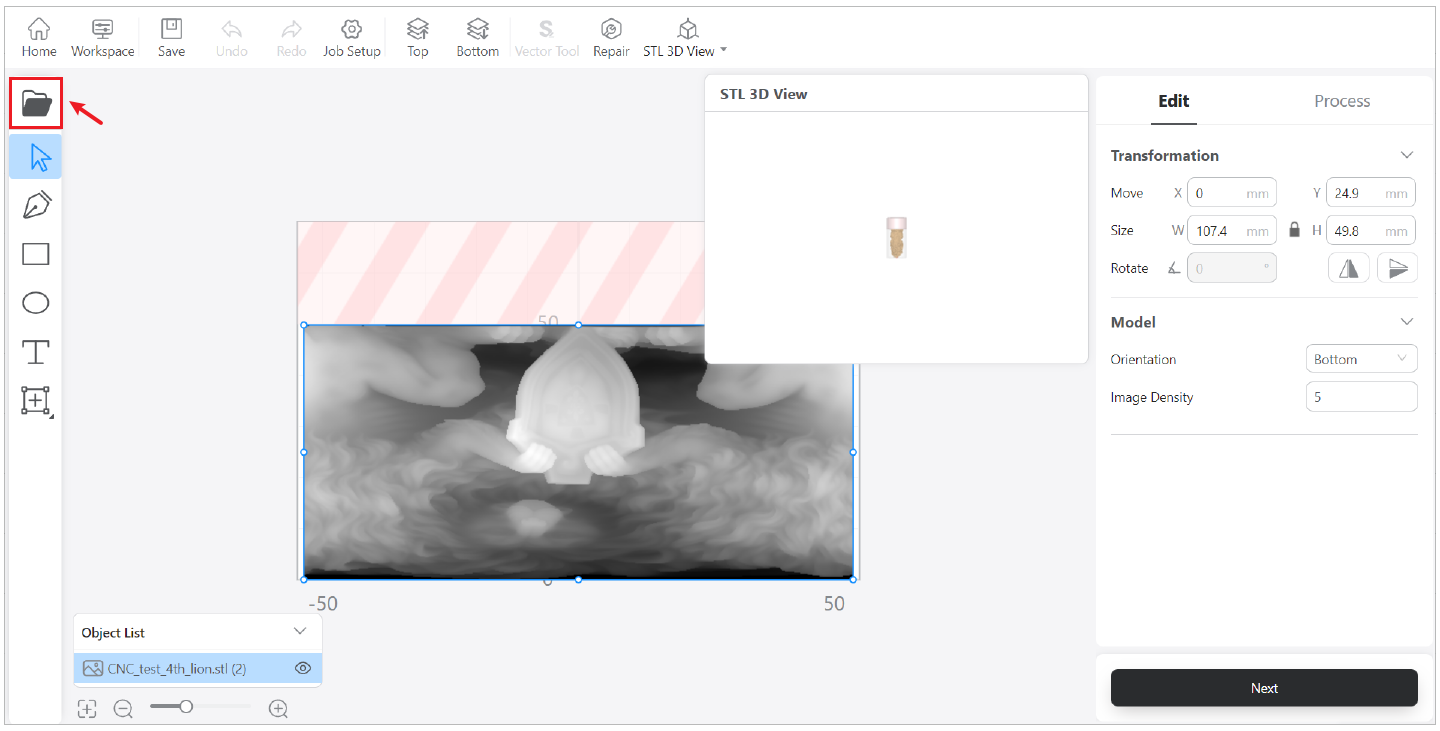
Please note that there may be bugs when importing files in .amf and .3mf. If you encounter any problems, please submit a support ticket to contact our technical support team.
- Alternatively, you can draw simple objects, add text or insert vector shapes for laser work.

The canvas in the Snapmaker Luban equals the lateral area of your material. After you input the diameter and length of your material, Luban will adjust the size of the canvas. You should put your object within the canvas. The stripe-highlighted area is where the material is clamped by the 3-jaw chuck.
- Select the object, then Luban will display the Edit Panel where you can transform the object, switch the Processing Mode. Besides, you can also edit the objects with the tools in the top toolbar, e.g., Top/Bottom. Then click Next when you finish editting, Luban will direct you to Process Panel.
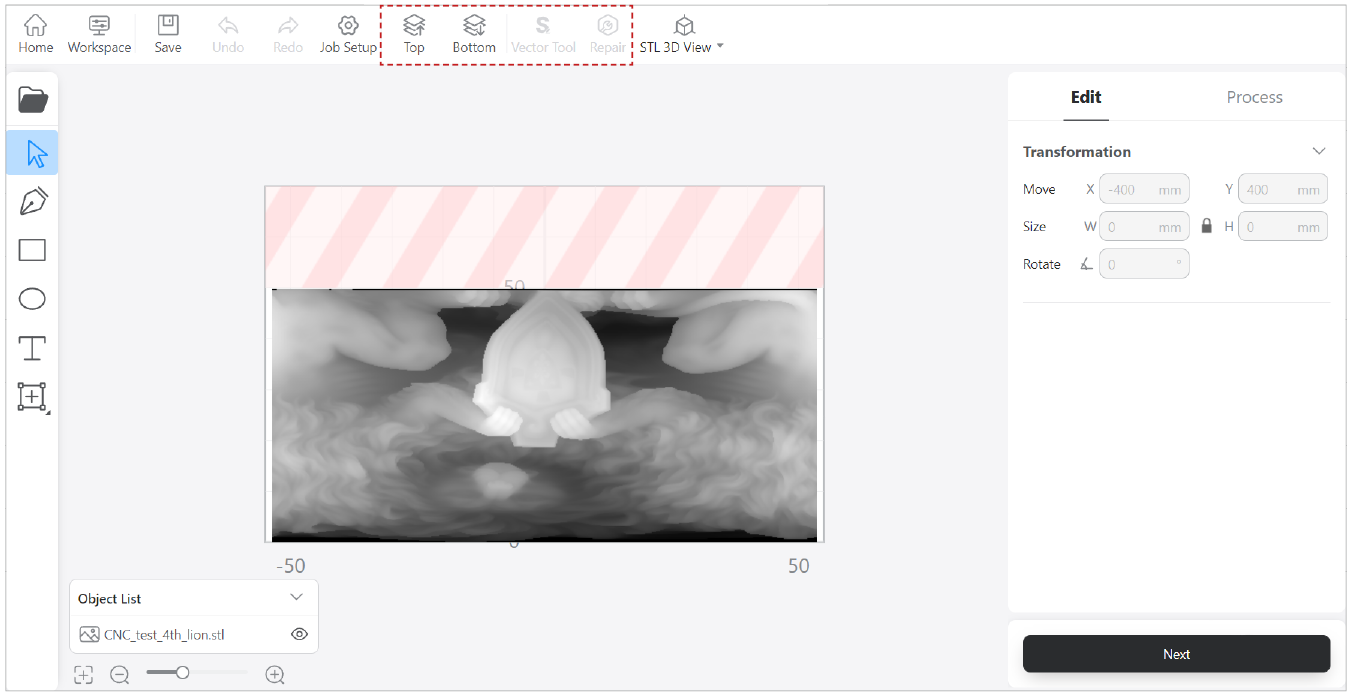
- In the Process Panel, select the object, then click Create Toolpath to create a toolpath for the object.
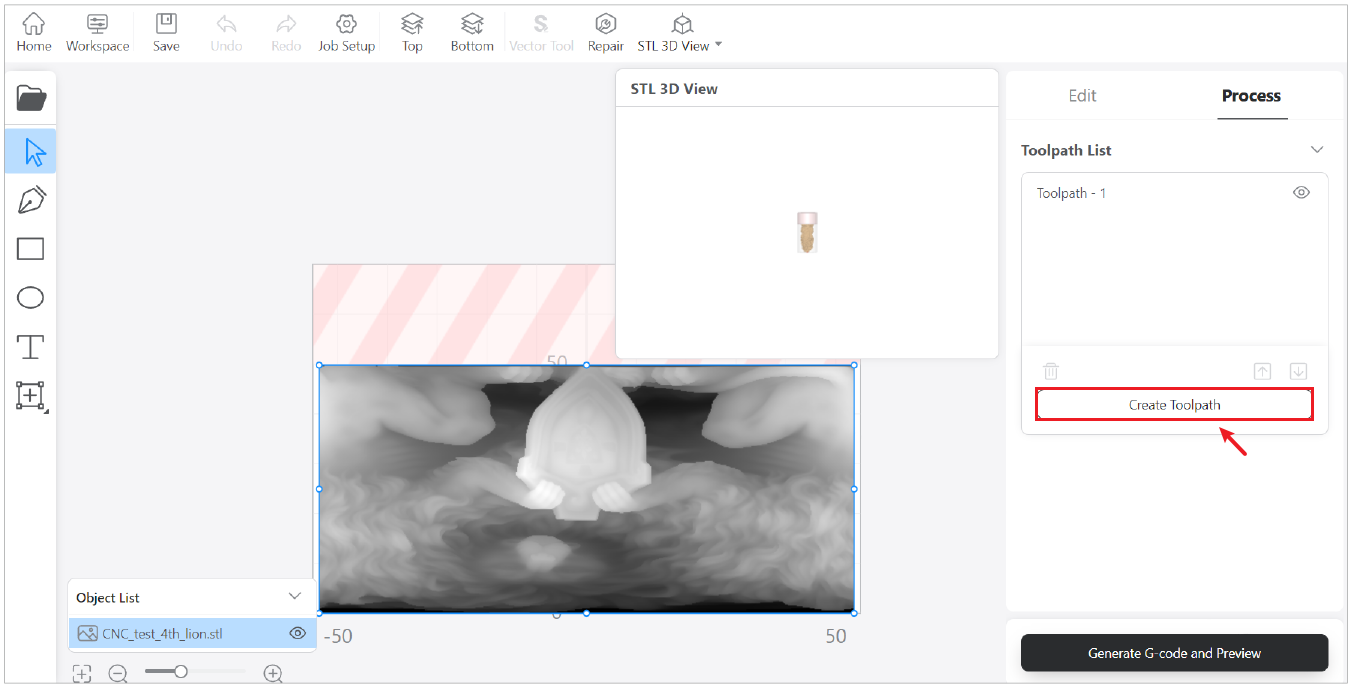
- In the pop up Toolpath Settings, use Luban's default settings, then click Save.
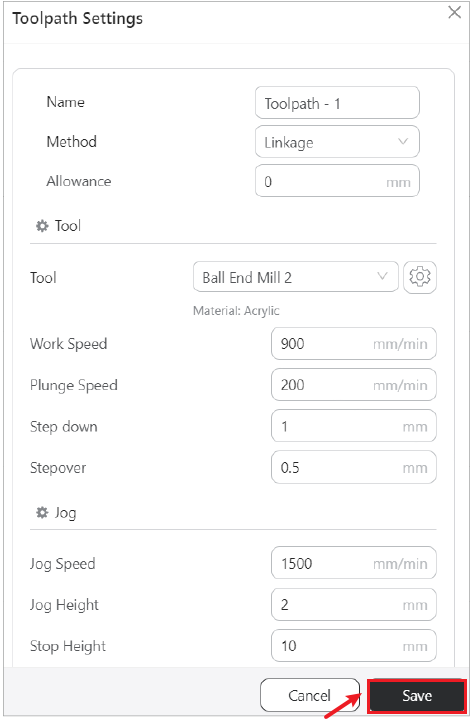
You can also modify the parameters based on your needs.
- Click Generate G-code. Once done, Luban will direct you to the Preview pane to preview the sliced effect.
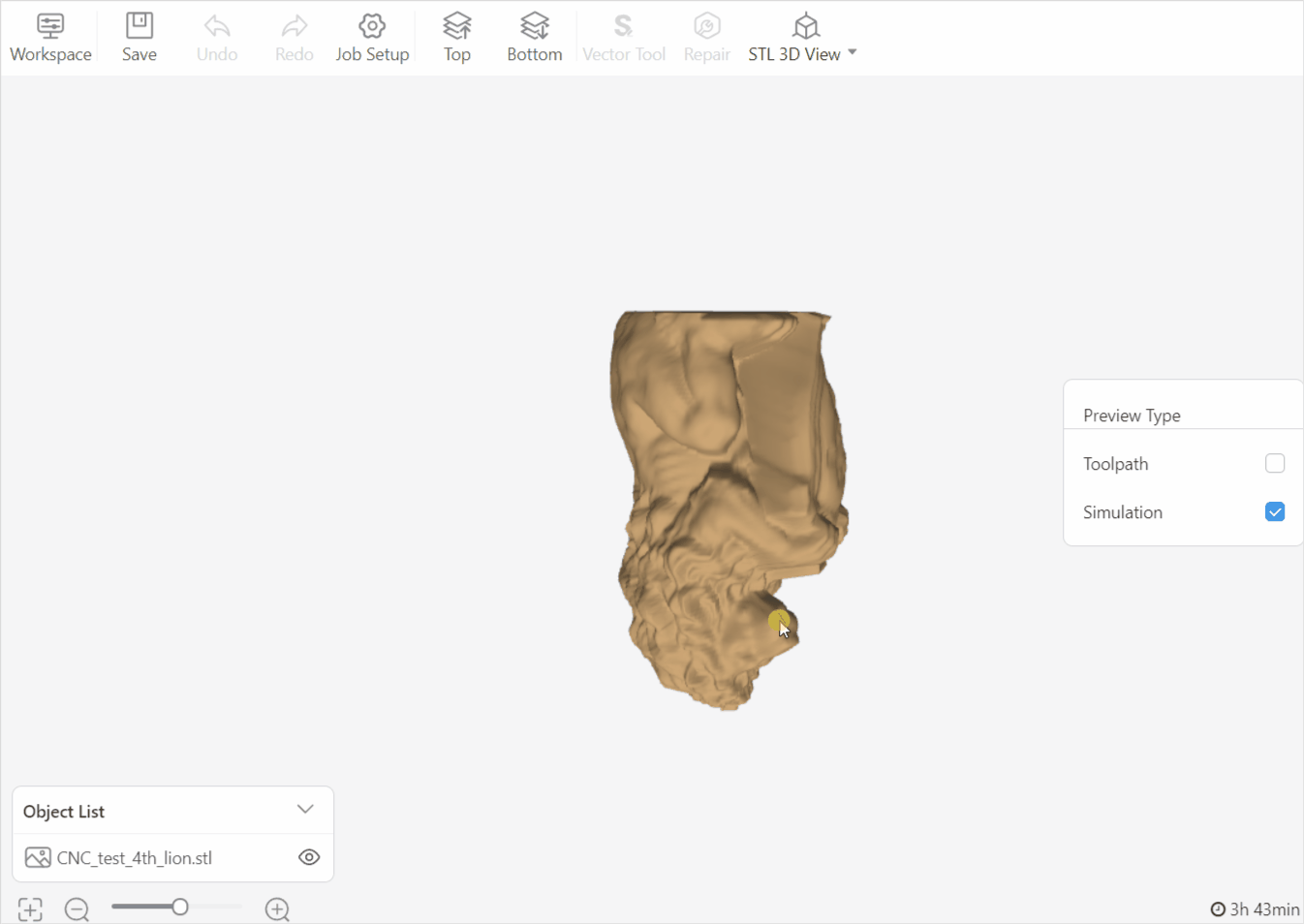
- Click Export > Load G-code to Workspace.

Alternatively, you can also click Export G-code to File to export it to USB flash drive, transfer it to your machine, then follow the Touchscreen instructions to start CNC engraving or cutting it there.
- Click Start on Luban.
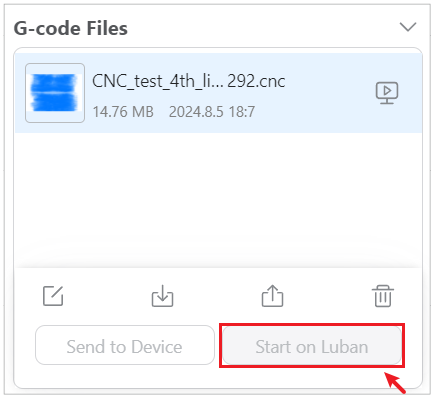
Before clicking Start on Luban, make sure that you have clamped the material, installed CNC bit and set the work origin. And run boundary to check if the work origin are correct.
Alternatively, you can also click Send to Device to send the G-code file to Touchscreen, then follow the Touchscreen instructions to start CNC engraving or cutting it there.

